Statement by President Joe Biden on the Crisis in Ethiopia
Written by The White HouseBRIEFING ROOM
MAY 26, 2021 • STATEMENTS AND RELEASES
I am deeply concerned by the escalating violence and the hardening of regional and ethnic divisions in multiple parts of Ethiopia. The large-scale human rights abuses taking place in Tigray, including widespread sexual violence, are unacceptable and must end. Families of every background and ethnic heritage deserve to live in peace and security in their country. Political wounds cannot be healed through force of arms. Belligerents in the Tigray region should declare and adhere to a ceasefire, and Eritrean and Amhara forces should withdraw. Earlier this week, the UN Office of Humanitarian Affairs warned that Ethiopia could experience its first famine since the 1980s because of this protracted conflict. All parties, in particular the Ethiopian and Eritrean forces, must allow immediate, unimpeded humanitarian access to the region in order to prevent widespread famine.
The United States urges Ethiopia’s leaders and institutions to promote reconciliation, human rights, and respect for pluralism. Doing so will preserve the unity and territorial integrity of the state, and ensure the protection of the Ethiopian people and the delivery of urgently needed assistance. The Government of Ethiopia and other stakeholders across the political spectrum should commit to an inclusive dialogue. Working together, the people of Ethiopia can build a shared vision for the country’s political future and lay the foundation for sustainable and equitable economic growth and prosperity.
The United States is committed to helping Ethiopia address these challenges, building on the longstanding ties between our two nations and working with the African Union, United Nations, and other international partners. U.S. Special Envoy for the Horn of Africa Jeff Feltman is leading a renewed U.S. diplomatic effort to help peacefully resolve the interlinked conflicts across the region, including a resolution of the dispute over the Grand Ethiopian Renaissance Dam that meets the needs of all parties. Special Envoy Feltman will return to the region next week and keep me apprised of his progress. America’s diplomacy will reflect our values: defending freedom, upholding universal rights, respecting the rule of law, and treating every person with dignity.
###
Source=Statement by President Joe Biden on the Crisis in Ethiopia | The White House
ርእሰ-ዓንቀጽ ሰዲህኤ
ኣብዚ ዝሓለፈ መዓልታት ኣብ ኤርትራዊ መድረኻት ኣዛረብቲ ካብ ዝቐነዩ ዛዕባታት ሓደ ዝኽሪ መበል 30 ዓመት ናጽነት ኤርትራ እዩ። ጽምዶ ኤርትራን ኢትዮጵያን ኣብ ውግእ ትግራይን ብሰንክዚ ኣብ ኤርትራውያን ዝምዕብል ዘሎ ናይ ኣረኣእያ ፍልልያት እውን መድረኽ ኣይለቐቐን። እነሆ ከኣ ናይ መገሻ እገዳ ሕቡራት መንግስታት ኣሜሪካ ኣብ ልዕሊ ህሉዋትን ቀዳሞትን መራሕቲ ኤርትራ፡ ኢትዮጵያን ህዝባዊ ወያነ ሓርነት ትግራይን እውን ናብ መደርኽ ወጺኡ ሓድሽ ኣዛራቢ ኮይኑ ኣሎ።
ኣብቲ ንዝኽሪ መዓልቲ ናጽነትና ዝምልከት፡ ኩለመዳያዊ ሕማቕ ህይወት ኤርትራውያን ድሕሪ ናጽነት ካብ ዘንቀሎ እንጽርጽሮት ዝተፈጥረ ዝመስል “ዝሓለፍናዮ ሰላሳ ዓመታት ናይ ናጽነት ዘይኮነ፡ ናይ ባርነት እዩ” ዝብል ድምጺ ውሑዳት ሓሓሊፉ ክስማዕ ጸኒሑ እዩ። እዚ ኣበሃህላ ከምቲ “እንተ ክንቡርኩት ዘይክንቡርኩት ኣብ ማይ ንብጻሕ” ዝበሃል፡ ናጻነትና ናይ ኩሉ እቲ ንመጻኢ እንውጥኖን እንቃለሰሉን ራህዋ፡ ቅሳነትን ልዕልና ፍትሕን መሰረት እዩ እሞ፡ ከይንጻብኦ ሓደራ ምባል ኣገዳሲ እዩ። ናጽነትናን ልኡላውነትናን ምስ ዲክታተር ኢሳያስ ደሪብና እነቆናጽቦ ዘይኮነ፡ ነብሱ ዝኸኣለ ብክቡር ዋጋ ሓርበኛ ህዝቢ ኤርትራ ዝተረጋገጸ መለለይናን ክብርናን ምዃኑ ዘይዝንጋዕ እዩ። ናጻ ሃገር እንተዘይትነብረናሞ፡ ከም ሃገራዊ መንነት ዘለዎ ህዝቢ ብዛዕባ መንግስታዊ ምምሕዳርን ዲሞክራስን ኣይምተዛረብናን።
ኣብ ዝኽሪ መበል 30 ዓመት ናጽነት ኤርትራ፡ ናይ ጉጅለ ህግደፍ ዓጀውጀውን ኮለልን ገዲፍካ፡ ኣብ ኤርትራዊ ሓይልታት ለውጢ፡ ሰልፍታት፡ ውድባት፡ ህዝባዊ ምልዓላትን ባእታታትን መልእኽቶም ከመሓላልፉ ቀንዮም። መብዛሕቶም ካብቶም መልእኽትታት ዘመሓላለፉ ካብ ዘይጓሰይዎም ዛዕባታት እዞም ዝስዕቡ ምጥቃስ ይከኣል። ንናጽነት ዝተኸፍለ ክቡር ዋጋን ናጻነት ፍረ ቃልሲ ኩሉ ኤርትራዊ ምዃናን፡ ምረት ኤርትራን ህዝባን ድሕሪ ናጽነትን ዝሓልፍዎ ዘለዉ ኣዝዩ መሪር ህይወትን፡ ነዚ ኤርትራን ህዝባን ዝሓልፍዎ ዘለዉ ጸልማት በዲህካ ኣብ ራህዋ ንምብጻሕ መሰረታዊ ተደላይነት ሓቢርካ ኣንጻር ህግደፍ ምቅላስን፡ ኣብዚ እዋንዚ ኣብ ጐረቤትና ትግራይ ዝካየድ ዘሎ ውግእ፡ ጽልዋኡ ኣብ ኤርትራን መዋጽኦኡን ዝብሉ ይርከብዎም።
ሓደ ካብቶም መልእኽቲ ዘመሓላለፉ፡ ኣቦመንበር ሰልፊ ዲሞክራሲ ህዝቢ ኤርትራ (ሰዲህኤ) ኣቶ ተስፋይ ወልደሚካኤል፡ ኣብ መልእኽቱ “ኣባላት ሰራዊት ኤርትራ ምስ ህዝብኹም ወግኑ ጥራይ ኣይኰነን ሕጂ እቲ ጻዋዒት። እቲ በደል ኣብ ርእሴኹም እውን ብጋህዲ ወሪዱ ኣሎ’ሞ ሃገርኩም ኣድሕኑ፡ ናጽነትኩምን ናጽነት ህዝብኹምን ዓቅቡ እዩ። ……… ፖሊቲካዊ ሓይልታት ኤርትራ ንውሽጣዊ ሓባራዊ ቃልሲ ኣቐዲመን ምትሕብባር የዕዝዛ ኣለዋ። እዚ ኩሉ ምዕባሌታት መስርሕ ውድቀት ምልኪ ከም ዝጀመረ እዩ ዘርእየና።” ዝብሎ ምጥቃስ ይከኣል።
ዳርጋ ቅድሚ 3 ዓመታት ከምዚ እዋን ኣብ ኤርትራዊ ኮነ ዞባዊ መድረኽ፡ ኣዛረብቲ ካብ ዝነበሩ ዛዕባታት ሓደ ርክብ መራሒ ጉጅለ ህግደፍ ኢሳያስ ኣፈወርቅን ቀዳማይ ሚኒስተር ኢትዮጵያ ዶ/ር ኣብይ ኣሕመድን ምንባሩ ይዝከር። ኣዛራራቢ ካብ ዝኾነሉ ቀንዲ ምኽንያት ከኣ፡ ግሉጽን ትካላውን ዘይምንባሩ እዩ። ነቲ ሽዑ ዝነበረ ናይ ክልቲኡ ሃገራት ዘይመሳሰል ኣገባብ ምምሕዳራት መዚኖም “እዞም መራሕቲ ኣበየናይ ኣተሓሳስባ ተረዳዲኦም እዮም ዝዛመዱ ዘለዉ?” ኢሎም ዝሓተቱ ብዙሓት ነይሮም። እዚ ከበሃል እንከሎ ግና ከምቲ ደሓር ብግብሪ ዝተራእየ፡ ቀንዲ ምቅርራቦም፡ ኣንጻር ህዝባዊ ወያነ ሓርነት ትግራይ (ህወሓት) ብሓባር ምኽታት ምንባሩ ሓበርቲ ምልክታት ኣይነበሩን ማለት ኣይኮነን። ብዘይካዚ እቲ ሓደገኛ ሃቐነ ኣንጻር ልኡላዊነትን ናጽነትን ኤርትራ ከም ዝነበረ እውን ዲክታተር ኢሳያስ ኣብ ዘዝኸዶ መድረኻ የርእዮ ብዝነበረ ቀልባዕባዕ ተጋሂዱ እዩ። እዚ ኢስያስ ዝፈጠሮ ሓደገኛ ስኽፍታ ሕጂ እውን ኣብ እንግደዓ ኩልና ኤርትራውያን ዘሎ እዩ።
በቲ ክጅመር ሽፉን ዝነበረ ሎሚ ግና እንዳሓደረ ዝገሃድ ዘሎ ዝምድና ናይዞም ክልተ መራሕቲ ዝተሰከፍና ኤርትራውያን ጥራይ ዘይኮና ኢትዮጵያውያን እውን ኣብ ዝተፈላልዩ ግምታት ተንጠልጢሎም ነይሮም። ብዙሓት “ዶ/ር ኣብይ ኣሕመድ ንኢሳያስ እንተ ኣረዲኡ እንተ ኣደናጊሩ ብውሕዱ ኣፍደገ ባሕሪ ከውህበና እዩ” ዝብል ትጽቢት ነይርዎም። እቲ ኢሳያስ ፈጺሙ ዘይግበኦ ክነሱ፡ ከምቲ “ዝብእስ ኣብ ዘይፈልጥዎ ዓዲ ከይዱ ቆርበት ኣንጽፉለይ በለ” ዝበሃል፡ ኣብ ልዕሊ ህዝቢ ኤርትራ ዝፈጸሞ ጥልመት ዝሕባእ መሲልዎ፡ ኣብ ኢትዮጵያ ከይዱ ጥዑይ መሲሉ ክቐርብ ስለ ዝፈተነ፡ ወርቂ፡ ዋልታን ኲናትን፡ ፈረስን ገመልን፡ ጋብን ቡንን ምስላሙ እውን መሰረቱ ሕልሚ ኣፍደገ ባሕሪ ዝደረኾ እዩ ነይሩ።
ደሓር ግና ኢትዮጵያውያን እውን ስኽፍታኦም ኣብ ዝምድና ዶ/ር ኣብይ ምስ ኢሳያስ፡ ሰማይ ዓሪጉ። ሎሚ እሞ ከኣ ናይ ኢትዮጵያ ቅልውላው፡ ካብ ምስ ትግራይ ኣብ ውግእ ምእታው ጀሚርካ ክሳብ ግዳይ እገዳ ሕቡራት መንግስታት ኣሜሪካ ምዃንን ካብ ብዙሓት ፈተውቲ ኢትዮጵያ ምንጻልን ጠንቁ፡ ምስቲ ንህዝቡን ሃገሩን ዘይኮነ፡ ”ከም ሲንጋፖር ሓሊሙ ትሕቲ ሰሜን ኮርያ ኮይኑ ዝተረፈ ሰብኣይ ምዝማድና እዩ።” ዝብል ናይ ብዙሓት ኢትዮጵያውያን ፖለቲከኛታት ሚዛን ኮይኑ ኣሎ። እዚ መረረ ኣብ ልዕሊ ህግደፍ ብመንግስታዊ ኣካላት እውን ጀሚሩ ኣሎ። ላዕለዋይ ኣኽባር ሕጊ ኢትዮጵያ መጽናዕቲ ኣካይዱ ኣብዚ ቀረባ መዓልታት “ውተሃደራት ኤርትራ ኣብ ትግራይ 110 ንጹሃት ሲቪል ቀቲሎም” ክብል ዝሃቦ ምስክርነት ምጥቃስ ይከኣል። መንግስቲ ኤርትራ ከኣ ነዚ ዝሃቦ ምላሽ የለን።
ናብቲ ቀንዲ ጉዳይና ንመለስ። ንመዓልቲ ናጽነት፡ ነቶም ምእንተኣ ዝተሰውኡ ጀጋኑና ዘለና ኣኽብሮት፡ ኣብታ ዕለት ብእነስመዖ መደረታትን ጭረሖታትን ጥራይ ኣይኮነን ዝግለጽ። እቲ ቀንዲ መግለጺኡስ ኣብ ባይታ ብግብሪ ከምቲ እንምድሮን እንጭረሖን እንተኮይና ጥራይ እዩ ትርጉም ዝህልዎ። ሓቢርና ተቓሊስና ንህግደፍ ከነወግዶ ተስፋን ተኽእሎን ከም ዘለና ዝረኣዩ ዘለዉ ምልክታት ናብ ግብራዊ ዓወት ክንቅይሮም ክንበቅዕ ይግበና። ምኽንያቱ ብዛዕባ ኤርትራን ህዝባን ዝሓሰብና ጽቡቕ እንተሓሰብናን ተስፋ እንተሕደርናን ብዘይካ ብሓባር ንጉጅለ ህግደፍ ኣወጊድካ፡ ካልእ መሰጐሚ ኣቋራጭ መንገዲ ስለ ዘየለ። “ድሕሪ መበል 30 ዓመት ዝኽሪ ናጽነትናከ ናበይ?” ናይ ዝብል ሕቶ መልሲ እምበኣር “ናብ ምውጋድ ጉጅለ ህግደፍ” ዝብል እዩ።
24 ጉንቦት 2021
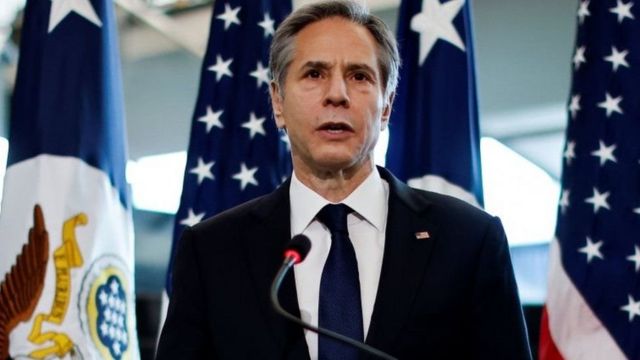
ምንጪ ስእሊ,REUTERS
ኢትዮጵያ ነቲ ኣመሪካ ኣብ ልዕሊ ሰበስልጣን መንግስቲ ኢትዮጵያ ዘንበረቶ እገዳ፡ "ግቡእ ዘይኮነ ጸቕጢ" እዩ ብምባል ተቓውሞኣ ገሊጻ።
ኣብ ጉዳይ ትግራይ ብደተደጋጋሚ ሻቕሎቱ ክገልጽ ዝጸንሐ መንግስቲ ኣሜሪካ ኣብ ልዕሊ ሰበስልጣን ኢትዮጵያን ኤርትራን እገዳ መገሻ ከምዘንበረ ኣፍሊጡ።
ሚኒስትሪ ጉዳያት ወጻኢ ኢትዮጵያ ሎሚ ኣብ ዘውጽኦ መግለጺ፡ እቲ እገዳ ኢትዮጵያ ሃገራዊ መረጻ ንምክያድ ኣብ እትሸባሸበሉ እዋን ዝተወስደ ምዃኑ ብምጥቃስ፡ ምስ ምምሕዳር ፕረዚደንት ጆ ባይደን ሃናጺ ዝኾነ ክልተኣዊ ዝምድና ንምምስራት ኣብ ዝስራሓሉ ዘሎ ከምዚ ዓይነት ስጉምቲ ግጉይ መልእኽቲ ዘሕልፍ'ዩ ኢሉ።
ጸሓፊ ጉዳያት ወጻኢ ኣሜሪካ ኣንቶኒ ብሊንከን፡ “ኣብ ትግራይ ዘሎ ህዝቢ ብግህሰታት ሰብኣዊ መሰላት፣ ጥቕዓታትን ግፍዕታትን ይሳቐይ ኣሎ፤ ብህጹጽ ዘድልዩ ሰብኣዊ ረድኤት ከኣ ብወተሃደራት ኢትዮጵያን ኤርትራን ከምኡ’ውን ካልኦት ዕጡቓት ጉጅለታት መሕለፊ ይእገዱ ኣለዉ” ክብል ኣረዲኡ።
“ማሕበረሰብ ዓለም ግብራዊ ስጉምቲ ዝወስደሉ እዋን እዩ” ዝበለ እቲ መግለጺ፤ ኣብ ልዕሊ ኣብ ስልጣን ዝርከቡ ወይ ነባራት ሰበስልጣን መንግስታት ኢትዮጵያን ኤራትራን እገዳ መገሻ (ቪዛ) ከምዝተነበረ ሓቢሩ።
ስርዑን ዘይስሩዕን ሓይልታት ክልል ኣምሓራ ከምኡ’ውን ኣባላት ህዝባዊ ወያነ ሓርነት ትግራይ ዝርከብዎም ኣባላት ሓይልታት ጸጥታን ውልቀሰባትን እውን መገሽኦም በቲ እገዳ ክግደብ’ዩ።
እዚ እገዳ ኣብ ልዕሊ’ቶም ነቲ ኣብ ትግራይ ዘሎ ኲናት ንምህዳእ ዝቐረበ ፍታሕ ክቕበሉ ወይ ክተሓባበሩ ቅሩባት ዘይኮኑ ኣካላት ዝተደንገገ ምዃኑ እቲ መግለጺ ኣነጺሩ’ሎ።
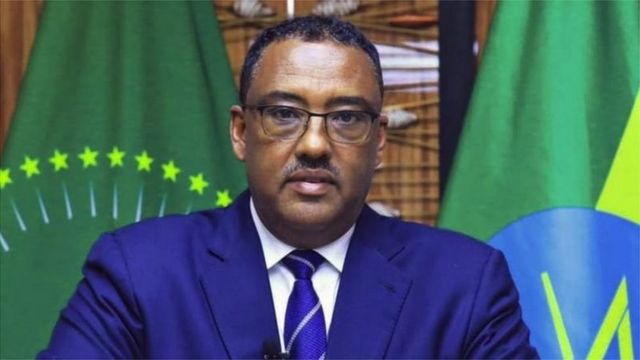
ምንጪ ስእሊ,MINISTRY OF FOREIGN AFFAIRS OF ETHIOPIA
ሚኒስተር ጉዳያት ወጻኢን ምክትል ቀዳማይ ሚኒስተርን ደመቀ መኮነን
“ኣብ ልዕሊ ህዝቢ ትግራይ ዓመጻትን ጥቕዓታትን ዝፈጸሙ ከምኡ’ውን ናብቲ ክልል ሰብኣዊ ሓገዛት ከይኣትው ዝኸልከሉ ዘተኣጓጎሉ ዘጠቓልል’ዩ” ይብል መግለጺ ሚንስትሪ ጉዳያት ወጻኢ ኣሜሪካ።
ብተወሳኺ ድማ ምስቶም ሰባት ቀጥታዊ ዝምድና ዘለዎም ኣባላት ቤተሰብ በቲ እገዳታት ከምዝሕጸሩ ተፈሊጡ።
“ነቲ ኣብ ትግራይ ዘሎ ኲናት ንምፍታሕ ዝቐረበ ሐሳብ ቅቡል ብዘይምግባር ሓላፍነት ዝወስዱ ኩሎም ካብ ኣሜሪካን ማሕበረሰብ ዓለምን ተወሰኽቲ ስጉምትታት ይጸበዩ” ኢሉ’ሎ።
ካልኦት መንግስታት እውን ነዞም ስጉምትታት ክወስዱ ጸዊዑ።
መንግስቲ ኣሜሪካ ኣብ ልዕሊ ንኢትዮጵያ ዝገብሮ ዝነበረ ቁጠባውን ጸጥታውን ደገፋት ሰፋሕቲ ገደባት ከምዘቐመጠ ይሕብር። እዚ ድማ ንፖሊሲ ቑጽጽር ወተሃደራዊ ንግዲ ግብራዊ ዝገብር ከምዝኾነ ኣመልኪቱ።
“እቲ ኣብ ልዕሊ ንኤርትራ ዝግበር ዝነበረ ሓገዛት ብዝምልከት ተነቢሩ ዝጸንሐ ሰፊሕ እገዳታት ድማ ብዝነበሮ ክቕጽል’ዩ” ክብል ኣዘኻኺሩ።
ኣብ ትግራይ ንዘሎ ኲናት ከኣ ዘተኣማመን ፖለቲካዊ ፍታሕ ክግበር ደጊሙ ዝጸውዐ መንግስቲ ኣሜሪካ “ነቲ ኣብ ትግራይ ዘሎ ቅልውላው ንምፍታሕ ኮነ ኢትዮጵያውያን ኣብዚ እዋን ኣብ ሞንጎኦም ዘሎ ምክፍፋላት ብዕርቅን ዝርርብን ንምፍታሕ ዝግበር ጻዕርታት ንምድጋፍ ቅሩባት ኢና” ክብል ሓቢሩ።
እንተኾነ ግን "ኣሸባሪ ተባሂሉ ምስ ዝሰየመ ህወሓት ምዝርራብ ከም ዘይክኣል ኣብ ግምት ክኣቱ ኣለዎ" ክብል'ውን፡ ነቲ ንግጭት ትግራይ ንምፍታሕ ብኣመሪካ ዝቐረበ ጻውዒት ሰላማዊ ፍታሕ ከምዘይቅበሎ ሚኒስትሪ ጉዳያት ወጻኢ ኢትዮጵያ ኣፍሊጡ።
ኣብ ዝሓለፈ ሰሙን ሰኔት ኣመሪካ፡ ኣብ ትግራይ ዘሎ ተጻብኦታት ጠጠው ክብልን መንግስቲ ኤርትራ ወተሃደራቱ ብቕልጡፍ ከውጽእን ዝብል ውሳነ ምሕላፉ ዝዝከር እዩ።
ኣብ ኣዲስ ኣበባ ዝወጽኡ ገለ ሰልፈኛታት “ካብ ኢትዮጵያ ኢድኩም ኣልዕሉ” ዝብል ጭርሖ ተሓንጊጦም ተቓውሞ ምስመዖም ድማ ይዝከር።
ኬሚካላዊ መጥቃዕቲ
ኣብ ትግራይ ኲናት ካብ ዝተወለዓሉ እዋን ጀሚሩ ብኣሽሓት ሰባት ክቕተሉ ከለዉ ካልኦት ብዙሓት ከኣ ካብ መረበቶም ተፈናቒሎምን ተሰዲዶምን።
ኩሎም ኣብቲ ኲናት ዝሳተፉ ኣካላት ድማ በቶም ዝፍጸሙ ጥሕሰት ሰብኣዊ መሰላት ክኽሰሱ ጸኒሖም'ዮም።
መንግስቲ ኢትዮጵያ ትማሊ ኣብ ዘውጽኦ መግለጺ ኣብታ ብኲናት ትህሰ ዘላ ትግራይ ሲቪል ዜጋታት ሰራዊት ኢትዮጵያን ኤርትራን ብዝፈነውዎ "መጥቃዕቲ ኬሚካለዊ ኣጽዋር ግዳያት ኮይኖም" ንዝብል ነጺጉ'ሎ።
እንግሊዛዊ ጋዜጣ ቴሌግራፍ ኣብ ዘቃልሖ ጸብጻብ፡ ብዙሓት ሰባት ኣዝዩ ብዘስካሕክሕ ኩነታት ኣካላቶም ብጻዕዳ ፎስፎሮስ ነዲዱ ኣብ ስቓይ ከምዝርከቡ ሓቢሩ ነይሩ።
ጸብጻብ ቴሌግራፍ፡ ኣብ ዝሓለፈ ወርሒ መንበሪ ገዝኣ ዝተወቕዐ ሓንቲ ቆልዓ 13 ዓመት ኣካላታ ነዲዱ ኣብ ከቢድ ስቓይ ከምእትርከብን ሓንቲ ካብ ሞንጎ ግዳያት ምዃናን ኣመልኪቱ።
እቲ ኬሚካል ኣብ ዓውደ ውግእ ምጥቃም'ኳ ዝከኣል እንተኾነ ኣንጻር ሲቪላት ኣብ ረብሓ ምውዓል ግን ከም ገበን ኲናት'ዩ ዝቑጸር።
ኣመዓባብላ ናይቲ ኵናት
ኣብ መንጎ ፈደራላዊ መንግስቲ ኢትዮጵያን ብህወሓት ዝምራሕ ዝነበረ መንግስቲ ክልል ትግራይን እናገደደ ዝመጸኣ ፖለቲካውን ሕገመንግስታዊን ምትፍናን ድሕሪ 3 ሕዳር 2020 ናብ ቅሉዕ ኲናት ኣምሪሑ።
ጠንቂ ናይቲ ፖለቲካዊ ምትፍናን ኣብ መጋቢት 2018 ዝጀመረ ኮይኑ ምስ ምምጻእ ቀዳማይ ሚኒስተር ናብ ስልጣንን ምድኻምን ምድፋእን ህወሓት ካብቲ ንልዕሊ 27 ዓመታት ብዓብላልነት ዓትዒትዎ ዝነበረ ፈደራላዊ ስልጣንን ዝተኣሳሰር'ዩ።
ኣብ ሕዳር 2019፡ ኢህወዴግ ውሁድ ገዛኢ ሰልፊ ክኽውን ድሕሪ ምውሳኑ፡ ህወሓት ነቲ ውሳነ ስለዘይተቐበሎ ከምዝወጽእ ኣነጺሩ። ኣብ ክፍላ ሕዳር ናይቲ ዓመት ኢህወዴግ ናብ ብልጽግና ምስተቐየረ ድማ እቲ ፖለቲካዊ ፍትሕ ወግዓዊ ኮይኑ። በዚ ድማ ብልጽግና ገዛኢ ሰልፊ ኮይኑ፡ ህወሓት ከኣ ከም ተቓዋሚ ሰልፊ ኣንጻር እቲ ብዶ/ር ኣብዪ ዝምራሕ ብልጽግና ደው ኢሉ።
ኣብ መጋቢት 2020 ሃገራዊ ቦርድ ምርጫ ነቲ ኣብ ወርሒ ነሓሰ ናይቲ ዓመት ክካየድ ተወጢኑ ዝነበረ ሃገራዊ ምርጫ ኢትዮጵያ ብሰንኪ ለበዳ ኮሮናቫይረስ ከምዝተናውሐ ድሕሪ ምግላጹ፡ ህወሓት ነቲ ለበዳ ብዝከላኸል ኣገባብ ክካየድ ይኽእል'ዩ ዝብል ምጉት ብምልዓል ነቲ ምንዋሕ ኣይተቐበሎን።
እቲ ኣብ ወርሒ መስከረም ናይቲ ዓመት ዕድመ ስልጣኑ ከብቅዕ ዝነበሮ ቤት ምኽሪ ፈደረሽን ንውሳነ ኮሚሽን ምርጫ ብምርዓም፡ ዕድመ ስልጣን ፈደራላውን ክልላውን መንግስታት ክናዋሕ ውሳነ ኣሕሊፉ።
ህወሓትን እቲ ንሱ ዝመርሖ ክልላዊ መንግስቲ ትግራይን ብወገኖም፡ እቲ ውሳነ "ዘይሕገመንግስታዊን" "ዘይሕጋውን" ብምባል ንውሳነ ናይቲ ቤትምኽሪ ነጺግዎ። ነቲ ብቀዳማይ ሚኒስተር ኣብዪ ዝምራሕ ፈደራላዊ መንግስቲን ክልቲኡ ባይቶታትን ኣፍልጦ ከምዘይህቦም'ውን ኣፍሊጡ።
እቲ ውሳነ ቅድሚ ምሕላፉ'ውን፡ እታ ኣፈጉባኤ ናይቲ ቤት ምኽሪ ዝነበረትን ኣባል ፈጻሚ ስራሕ ህወሓትን ዝነበረት ወ/ሮ ኬርያ ኢብራሂም እቲ ውሳነ ከይሓለፈ እንከሎ ተቓውሞኣ ንምግላጽ ኣብ ወርሒ ሰነ 2020 ብፍቓዳ ካብ መዝነታ ወሪዳ።
ባይቶ ወከልቲ ህዝቢ ንውሳነ ሃገራዊ ቦርድ ምርጫን ቤት ምኽሪ ፈደረሽንን ድሕሪ ምጽዳቑ ኸኣ፡ ባይቶ ክልል ትግራይ ናይ ባዕሉ ምርጫ ከካይድ ብ12 ሰነ 2020 ወሲኑ።
ሃገራዊ ቦርድ ምርጫ ኢትዮጵያ ነቲ ክልላዊ ምርጫ ከካይዶ'ኳ ብወገን ትግራይ ጠለብ ቀሪቡሉ እንተነበረ፡ ስለዝነጸጎ፡ ቤት ምኽሪ ክልል ትግራይ ናይ ባዕሉ ኮሚሽን ምርጫ ከቕውም ተገዲዱ።
ብ9 መስከረም 2020 ድማ ምሉእ ብምሉእ ህወሓት ዝተዓወተሉ ክልላዊ ምርጫ ተኻይዱ።
ድሕሪ'ዚ ክልቲኦም ወገናት ኣፍልጦ ተነፋፊጎም፡ ኣብ ናይ ቃላት ውግእ ኣትዮም። እቲ ዝነበረ ወጥርን ምትፍናንን እናገደደ ድሕሪ ምምጽኡ ድማ፡ ተኽእሎ ኵናት እናዓበየ መጺኡ።
ግንቦት 24 ዝተባረኸትን ብጽእትን ዕለት ነጻነት ህዝቢ ኤርትራ ኢያ። ንዓና ኤርትራውያን ካብ ኲለን መዓልታት ልዑል ክብሪ ኣለዋ። ንዂሉ መግዛእቲ ኣብ ጎሓፍ ደርብያ። ስዒበን ዝመጻ መዓልታት: ሰሙናት: ዓመታትን ዘመናትን ታሪኽ ክብርን ሓበንን ምዕባለን ከስምዓ ደገ ዝኸፈተት: ብርሃን ዘጓነጸፈት ክነሳ: ብሰንኪ ጠላማት መራሕቲ ህግደፍ ስውኣትና ዘይሓለምዎ: ብህይወት ዘለና ዘይተጸበናዮ ከሰል ኣምሲሎም ንውቃበኣ ኣደዊኖማ ኣለው።
ቅድሚ 30 ዓመት ዝነበረት ወጋሕታ ዕለት 24 ግንቦት ዝተሃርመት ነጋሪት: ኣብ እዝኒ ብዙሓት ሃገራት ዓለም ጋሻ ነይራ። ብዙሓት ኣብ ጒዳይ ኣርትራ ሓሳባቶም ተዛቢዑ ኣእምሮኦም ብትምክሕቲ ሰኺሩ: ዝዓጠቐን ንዝመከተን ህዝባዊ ሓርነታዊ ቃልሲ ብዝሒ ብረትን ሓጺንን ብምእማን ንቖራጽነትን ውሳኔ ህዝባ ንነጻነትን ልዑላውነት ኤርትራ ከስትብህሉ ዘይከኣሉ መልሓሶም ኣሓይኻ።
ግንቦት 24 ብንቕሓት ዝዓጠቕን ንዝመከተን ሓርነታዊ ህዝባዊ ቃልሲ ንድሕሪት ዝገትእ የለን ዝብል ፍልስፍና ኣብነት ብምዃን: ኣብ ቅድሚ ዓይኒ ብዙሓት ኣኽሊል ወርቂ ነጻነት ኣብ ክብ ዝበለ መዓርግ ከተደይብ ዝበቕዐት`ያ። እዛ ዕለት`´ዚኣ መቓልሓን መኣዛ ክብራን ኣብ ዶባት ኤርትራ ከይተሓጽረ፣ ኣብ ከባቢ ኤርትራ ኣፍሪቃን ዓለምን ተንበልብል ኣላ። ኤርትራ ኣባል ኣፍሪቃን ዓለምን ኮይና ተፈሊጣ። እዚ ቅድሚ 30 ዓመት ኣይነበረን። እቲ ክብሪ ግን ብሰንኪ ጻሕተርቲ ሕሰምን ዓመጽን ኣባልነታ ኣብ ዓለም ኣርስሖም ንስማ ኣባላሽየሞ ኣለው።
ኣብቲ ብለይትን ቀትርን ዝርገጽ ዘሎ ጎደናታት ኤርትራ: ኣብቲ ሓረስታይን ጓሳን ዝባኑ ቀሊዑ ከፍርየሉ ዝነበሮ ግርሁን ጎላጒልን ጎቦታትን ስንጭሮታትን: ሰላምን ዕረፍትን ተሓሪሞም ጥቕምን ርብሓ ምልክን ህግደፋውያን ንምሕላው ኣብ መዓስከራትን ድፋዓትን ተዳጒኖም ባርነታዊ ህይወት የሕልፉ ኣለው። ህዝቢ ኤርትራ ዘይግብኦ መከራን ሕሰምን ”ብደቁ ኢና” ዝብሉ ዘይተጸበዮ ሓደጋ ኢዩ ረኺቡ። መግዛእታዊ ዘመናት ሓሊፉን ተሰጊሩን ኤርትራዊ ናይ መሬቱን ንብረቱን ጎይታ ክኸውን ተጸብዩ። እዚ ተርፉ ነታ ዘላቶ ህይወት እውን ዋሕስነትን ቅሳነትን ኣብ ዘይብሉ ጸልማት ተጻጢሑ ይርከብ። ሽምገለታት ኣምዑቶም ብጓሂ ሓሪሩ መርጎሞም ንህግደፋውያን ንሰማያት የዕርጉ ኣለው።
ክብሪ ንዕለተ ነጻነት 24 ግንቦት! ኣታ ብህይወት ዘለኻ ኤርትራዊ ኣብ ደገ ይኹን ኣብ ውሽጢ ዕድለኛ ኢኻ ዝበሃለሉ ግዜ ኢና ከነብዕል ነይሩና። እንተኾነ ብሰንኪ ጨካንን ትምክሕታውን ፖለቲካ እቲ ከይሲ መላኺ: መንእሰያትን ዓበይትን ኣብ ብዙሓት ሃገራት ምስዳዶምን ኣብ ውቅያኖሳትን ባሕርን ምደረበዳን ይጥሕሉን መላገጺ ድሑራት ስሱዓት ናይ ዘመንና ማፍያ ይኾኑ ምህላዎም፣ ነዚ ዝተገንዘበት ዓለም ብሰንኪ እዞም ሰብ ጸሊም ታሪኽ መመሰል ጉዕዙይ ምልካውነት ገይሮማ ኣለው።
እታ መሬት ሳዕሪ እኽሊ ካልእ ኲሉ ህይወት ዘለዎ ከተብቊል: ከተዕብን ክትምግብን ተጸብያ። ታሪኽ ጀጋኑኣ ክትዝክርን ከተኽብርን ሓወልቲ ስውኣታ ክትከልን ነይሩዋ። ኣብ ከርሳ ዝርከብ ማዕድናት ፍሒራ ስንኩላታ ክትኣሊ: ደቃ ከተምህር ህዝባ ሓቑፋ ክትሕብሕብ ሓሊማ። ገማግም ባሕራን ወደባትን ኣውቂባ: ንዓለምን ህዝብታታን ከተጋይሽ ነይሩዋ። ብሰንኪ`ዚ ሰራም ፍጡራ ኢሳያስ ኣፈወርቂ ኣብርሃ ግን: ኣብ ክንዲ ሰላምን ምዕባለን ትዕድም: ኤርትራ ውግእን ወረ ውግእን: ጥሜትን ዕርቃንን: ጽምእን ሕማምን ኰይና ኣላ። ኤርትራ ናይ ውሽጣ ሽግር ከይኣኽላ: በቲ ዘየቋርጽ ናይ ጥፍኣት ዕጣቑ ተሰንዩ ሕማቕ ታሪኽ ዕዳ ጒርብትና ድሕሪኡ ገዲፉ ዕምሩ ከቃላጥፍ ይሃልል ኣሎ። ነዚ ናብ ሕውነትን ሰናይ ጒርብትናን ምሕዝነትን ቀይርዎ። ድልየት እንተ ገርኩም እቲ መገዲ ክመርሓኩም ኢዩ።
ኣብ ከርሲ እዛ መሬት 100ሺሕ ስውኣት ኣለው። ግንቦት 24 እትዛረቦን ትነግሮን: ክብረይ ኣብኦም ዝተሰረተ`ዩሞ ዝበልዎን ዝወደቕሉን ዕላማ ዘክሩ ክትብል ምስቶም ሓርነታውያን ደለይቲ ፍትሕን ማዕርነትን ድምጻ ዓው ኣቢላ ትድሀ ኣላ። ነቶም ዘሕለፍክዎም ደቀይ ኣሰሮም ተኸቲልኩም ዝኽሮም ሰንደቕ ዕላማኹም ገርኩም: ኣገባብ ፖለቲካኹም ይጸብቕ: ጌጋታትኩም ይተኣረም: ብሕግን ቅዋምን ተሰርዑ፣ መገዲ ጥፍኣትን ዛረጊ ቅዲ ምልካውነት ቅበሩ። ሕጊ ዘይክተል ብዘይ ሕጊ´ዩ ዝጠፍእ ዝበሉ ደቀይ ኣብ ጸልማት ጋህስታት ይሳቐዩን ይሞቱን ንዘለው ዘኪርኩም ናይ ሓባር መደብ ሓርነት ሓንጽጹ። ነዚ ሎሚ ንዕለተይ ደዊኑ ዘሎ ኣቦ ጸልማትን ሓሶትን መልኣከ ሞት ጒሒፍኩም ብብርሃን ሓድነትን ማዕርነትን ስዒርኩም ክትክእዎ ኣጻብዕ ሓድነት እሰሩ። እቶም ብረት ኣብ ልዕሊ ኤርትራዊ ብኤርትራዊ ደው ይበል ዝበሉ: ኑዛዜኦም ንህዝቢ ዝገለጹ ኣብነት ኰይኖም ምስክረይ ዝዀኑ: በዚ እኩይ ጥልመት ዝዕጣቑ ዳጒንዎም ዘሎ ንዓይነይ ዘየቋርጽ መሪር ትኪ ኰይኑኒ ምህላው ዘክሩ።
ናይዛ ዕለተይ ዜናን መቓልሕን ክስማዕ ከሎ ክልተ ቃና ኣለዎ። እቲ ሓደ ትዕቢት ጎልያድ ኰይኑ ንደቀይ ዝኸፋፈለን ዝምቆሐን ኢዩ። እቲ ካልእ ቃና ንስመይ ቅኑዕ ስም ቦታ ሓርነት ሂቡ: ፍትሕን ደሞክራስን ኣስፊሑ: ኣብ ትሕቲ ሉዑላውነተይ ዘጽልል ኢዩ። ጽላለይ፣ ቁዋማዊ ሰርዓተይ መዕቆብ ኩሉኹም ደቀይ ደቂ ዕለተይ ኢኹም። ኣብ ትሕቲ ኣእጋርኩም ዘለው ሰማእታት ደቅኹምን ኣሕዋትኩምን ኣቦታትኩምን ባህ ክብሎምሲ: ንሰላምን ሓውነትን ሕሰቡ። መብጽዕኦም ክሕደስ ቃል-ኪዳን እሰሩን ስርሑን። ስውኣትን ስንኩላትን ደቀይ ነዞም ናይ ግዚኡ ኣጋንንቲ ኣይተሰውኡን ኣይሰንከሉን። ንሳቶምሲ ንዳሕራይ ወለዶ ዝኸውን ታሪኽ መንነት ንልዑላውነተይ እዮም መሰረት ሰሪቶም። ነዚ ሕድር´ዚ ብቑዓት ኮንኩም ክትርከቡ ትኽእሉ ኣብ ትሕቲ ጽላል ልዕልናይ ምስ እትእከቡ ኢዩ። ጒዕዞኹም ጸበባን መከራን: ምስጓጒን ምጽላምን ኣለዎ። ድሕሪ ጽቓይ ራህዋ ከም ዝህልዎኩም ግን ጭቡጥ ግበርዎ።
ኣብ ትሕቲ ልዑላውነተይ ኣጽሊልኩም ድላይኩም እመኑ። ኣብ ዝመረጽኩሞ ተጠርነፉ። እዚ ክትውለዱ ከሎኹም ኣትሒዙ ዝተዓደለኩም ዘይትንከፍ ብጹእ ህያብ ኢዩ። ኲሉ ግዜ ግን ብዘተን ምይይጥን ኣሰንይዎ። ኣነ ንኹሉኹምን ምስ ኩሉኹምን ኢየ። ንነብሲ ወከፍኩም ብሓደ ዓይኒ ኢየ ዝርእየኩም። ንስኹም`ውን ተኻባቢርኩም ብማዕርነት ተሓቛቖፉ። እዚ እንተገርኩም ጸላኢኹም ክትስዕሩ ኢኹም። ንሱ እቲ ስሱዕ ምስ ጠፍአ ድማ ኩሉ ምዕባለ ክትጓናጸፉ ኢኹም። ከመይሲ ከምቲ ኣቐዲመ ዝበልኩኹም ንኹሉኹም ዝኣክል ምንጪ ሃብቲ ኣሎኒ።
ኣነ 24 ግንቦት ክሳብ ሎሚ ደው ክብል ዝኸኣልኩ ኣብ ትሕቲ መሬተይ ዘለውን ምስ ቃንዝኦም ብህይወት ዘለውን ደቀይ ኣንጊሆም ስለዝተባራበሩለይ ኢዩ። ዝተኸልዎ ዕላማ ብዂሉ ይተሓሎ። እቲ ዕማም ፍስሃ ሓርነት ጀሚርኩሞ ኣለኹም። እቲ ዕላማ ክብጻሕ ድማ ተጊህኩም ስርሑ። ነዊሕን ዝተሓላለኸን ጒዕዞ ከም ዘለኩም ካብ ምግንዛብ ኣይትሰልክዩ።
ባዛዕባቶም ቀደም በቲ ቀዳማይ ጸላኢ ዘርምዘርሞ ዝኣተዎም ደቀይ ብዙሕየ ዘስቆርቊር። ቅድሚ 30 ዓመት ደው ካብ ዝብል ኣትሒዘ ኢደይ ዘርጊሐ ንዑ ክብል ምስ ጀምርኩ: እቲ ርኹስ ናይ ውሽጢ ጸላኢ ንዝርጉሕ ዓዳሚ ኢደይ ስለ ዝዓንቀፎን ወሲኹ እውን ስለዘግደዶን ብማዕዶ ከም እንርአአ ገይሩና ኣሎ። ግሉጹን ዘይተገልጸን ናፍቖቶም ኣብ ውሽጦም ኰይኑ ክሕይኾም ከሎ ንቖላሕታይ ይመሮ ኢዩ። ኣውራኳ ብዛዕባ ዝወልድዎምን ቀጺሎም ዝውለዱን ብዙሕየ ዝሓስብ። ከምቲ ቀዲመ ዝበልኩኹም ከኣ እቲ ሕሱም ናይ ውሽጢ ጸላኢ ንሱ ከይኣኽሎ: ምሳይ ዝጸንሑን ኣብ ልዕልነተይ ዝተወልዱን ኣብ ምብታኖም ይታናዀል ኣሎ። ካብ ባሕሪ ከብደይ ዝወጸ መርገም ግን ኣይከስሮርንዩ`ሞ ርግኡ። ምሳኹም ምስ ኣብ ውሽጥን ደገን ዘለኹም ኣኽበርቲ ሉዑላውነተይ ድማ ልበይ እሱር ኢዩ።
ዝኸበርኩም ደቀይ ደቂ ግንቦት 24! ኣነ ብዝንተ ሞጎት ዝተሰኔኹ ኢየ። ካብቲ መሪር ጓህየይ ንዓኹም ምርካበይ ተስፋይ ዓቢ ኢዩ። ሎሚ 24 ግንቦት ዕለተይ ስለዝኾነት ኩሉኹም ብኣይ ሕሰቡ። ዝተኸፍተ ባብ ነጻነት መሊሱ ከይግፍተን ዕጥቁኹም ኣጽንዑ። ካብዚ ጒሒላ ተጠንቀቑ። ኣብዛ ዕለተይ ብዝገብሮ ዳንኬራ ሓሶት እይትተሃመሉ። ቁስለይ ዝጐድእ ጓይላ ካብ ምግባር መዝሙር ሽሕጣን ካብ ምዝማር ደው ኣይክብልንዩ። እዚ ግን እቲ ግዳማዊ ናይ ሞቱ ዋዜማ ኢዩ። ኣብቲ ዕያግ ርስሓቱ ዝሕንብሱ ተረፍ ኣለው። ብኣዳናጋሪ መናውርኡ ዝኣሰሮምን ከም ጣኦት ዘምልኽዎን ውሑዳት ኣለውዎ። ልቦም ዝሰረቖም ብጣዕሳ ሕኒን ዝብሉ ኣብ ውሽጡ ከም ዘለውኒ ኣይትርስዑ። ናይ ምትእስሳርኩም ግዜ ድማ ርሑቕ ኣይኮነን።
ክሳብ ትመጽእ ዕለተይ ደሓን ኩኑ።
መልእኽቲ ኣቦ መንበር ሰዲህኤ ብምኽንያት መዓልቲ ናጽነት
ብምኽንያት ግንቦት 24 መዓልቲ ነጻነት ኤርትራ ብኤርትራዊ ሃገራዊ ግንባር (ኤሃግ) ዝተዳለወ መግለጺ
Written by ኤርትራዊ ሃገራዊ ግንባርቃል ሰልፊ ዲሞክራሲ ህዝቢ ኤርትራ ንመበል 30 ዓመት መዓልቲ ናጽነት ኤርትራ
(ብፈነወ ቲቪ ኤሪሳት ዝተፈነወ)
ዝኸበርኩም ምምሕዳር ፈነወ ቲቪ ኤሪሳት፡
ኣብዚ ክቡር መዓልቲ ናጽነት ኤርትራ፡ ፖሊቲካዊ ሓይልታት ኤርትራ፡ ናብ ህዝብን ዓለምን መልእኽተን ከመሓላልፋ ብማለት ንዘቕረብምኩልና ዕድመ፡ ከም ሰልፊ ዲሞክራሲ ህዝቢ ኤርትራ ምስጋናና ነቕርብ። ኣብ’ቲ ናይ ሰላሳ ዓመት ዕድመ ናጽነት ኤርትራ፡ ቃልና ንኸይስማዕ ተዓፊኑ ጸኒሑ እዩሞ፡ ነዚ ዓፈና’ዚ ሰቢርኩም፡ ንጥሩምባ መንግስቲ ምልኪ ጥሒስኩም፡ ነቲ ካልእ ኤርትራዊ ድምጺ ከተስምዑን፡ ነቲ መሰረታዊ ባህጊ ኤርትራውያን ከተቃልሑን ምምራጽኩምን ምኽኣልኩምን፡ ኣብዚ ዕለተ ናጽነት ዕዙዝ ሃገራዊ ክብሪ ልበሱ። ሕጂ’ውን ኤሪሳት፡ ምስ ኩለን’ተን ከምኡ ዝኣመሰላ ማዕከናት እናተሓባበረ፡ ቁልዒ ሓርነት ንከይቅህም ኩሉ ኤርትራዊ ድምጽታት፡ ዝፍነወሉ ማዕከን/መድያ ኰይኑ ክቕጽል ትምኒትና እዩ። ስለ’ቲ ውፉይ ስራሕኩም ኣገናዕ!
ክቡራት ተኸተታተልቲ!
ክቡር ህዝቢ ኤርትራ!
ቅድሚ ኩሉ ብስም ሰልፊ ዲሞክራሲ ህዝቢ ኤርትራ ዮሃና ንዕለተ ናጽነት እናበልኩ እንቋዕ ናብ መበል 30 ዓመት መዓልቲ ሃገራዊ ናጽነት ኣብቅዓና እብል። ምረት ባዕዳዊ ጭቆና እንፈልጥ ህዝቢ ኢና’ሞ፡ እንቋዕ ነታ ብረታዊ ተጋድሎና ብዓወት ናጽነት ዝዛዘምናላ ዕለት ዳግማይ ክንርእያን ከነስተማቕራን ኣብቅዓና። እዛ ንልዑላውነት ኤርትራና ህያው ዝገበረት መዓልቲ ክብርቲ እያ። ስለኣ ንዕልልን ንዝምርን። ስለ’ቶም ኣብ ምርግጋጻ ዝተሰውኡ፡ ዝሰንከሉ፡ ዝተሰደዱ፡ ጉልበቶምን ንብረቶምን ዘወፈዩ፡ ምዑታት ደቂ ሃገር ከኣ ዘልኣለማዊ ክብሪ ሞጐስን ዝኽርን ነተሓላልፍ።
ሎሚ፡ ኣብ 2021 ዓለምና ብሰሪ ተላባዒ ሕማም ኮቪድ19 ምንቅስቓሳቱ ደሪቱ ኣብ ዝርከበሉ ግዜ፡ ነዚ ክቡር መዓልቲ ናጽነት ከነብዕል ከለና፡ ነቲ ኣብ ውሽጢ 30 ዓመታት ዝገጠመና ንዝክር። ናጽነት ኣብ ዝተበሰረሉ፡ ከመይ ነበረ ኢልና ንሓትት? እወ፡ ስምዒታት ዓወት ገንፊሉ፡ መቐረት ናጽነት ጥዒሙ፡ ትጽቢታት ከኣ ሰማይ ዓሪጉ ነይሩ። ሓያሎ ክፋል ህዝብና ደጊም ሰላም ክነግስ፡ ህዝባዊ ሓርነት ክኽበር፡ ውግእን ወረ ውግእን ክጠፍእ፡ ሃገር ክትዕምብብ፡ ኣሳርን ተኣሳርን ዘይብሉ ሕብረተሰብ ክህነጽ፡ ኤርትራ ከኣ ብጐረባብታን ብዓለምን እትነኣድ ሃገር ክትከውን እዩ ዝብህግ ዝነበረ። ንሱ ጥራይ ዘይኰነ እቲ ዝወፈረ ብስላም ክኣቱ፡ እቲ ዝገሸ ክምለስ፡ እቲ ዝዘርአ ክዓጽድ እቲ ዝነገደ ክኸስብ እቲ ዝተማህረ ፍረ ትምህርቱ ክቐስም፡ እዩ ዝትስፎ ዝነበረ። ይኹን’ምበር ነዊሕ ከይተጓዕዘ እዚ ባህጊን ተስፋታትን ብእዋኑ ተቖጽዩ። ኣምሰያኡ፡ ምልኪ ነጊሱ፡ ኣብያተ ማእሰርቲ ሰፊሑን በዚሑን ግህሰት ሰብኣዊ መሰል ገዲዱ። ስለዚ ከኣ ፍርሂ ሳዕሪሩ፡ ግፍዒ፡ ሞት፡ ምስዋር በዚሑ፡ ካብዚ ዘምለጠ ከኣ ንሃገር ጠንጢኑ፡ ንሓደጋታት እናተቓልዐ ሰደት ክመርጽ ተገዲዱ።
እምበኣርከስ ናይ ሎሚ መዓልቲ ናጽነት፡ እቲ ሕሰም ኣብ ዝገደደሉ ኢና ነብዕሎ ዘሎና። ብዘይካኡ ነዚ ዕለተ ናጽነት ፍሉይ ዝገብሮ ዓበይቲ ምዕባሌታት’ውን ኣብ ሃገርናን ኣብ ዞባናን ተረኺቡ’ሎ። ናጻ ኤርትራና፡ ኣብ ዘይናታ ውግእ ተሸሚማ ኣላ። ሃገርና ዘይሻራዊ መርገጽ ሒዛ ናብ ጐደና ምዕባለ ኣብ ክንዲ ምምራሕ፡ ብሰንኪ’ቲ ዘይቅርዕዉ ኣመራርሓ ምልካዊ ስርዓት፡ ናብ ዘይምልከታ ውግእ ኢትዮጵያ ተሸኺላ ህይወት ንጹሃት ደቃ ተጥፍእ ኣላ። ብርእይቶና፡ እቲ ኣብ ኢትዮጵያ ዝተወልዐ ውግእ፡ ንውሽጣዊ ጉዳይ ኢትዮጵያ ዝምልከት፡ ናቱ ቅዋማውን ፖሊቲካውን መበገሲታት ዘለዎ ብምኻኑ፡ ኤርትራ ጦብሎቕ ዝብለሉ ጉዳይ ኣይነበረን። ይኹን’ምበር ብሰንኪቲ ዶር ኣብዪን ኢሳያስን ዝተሰማምዑሉ፡ ሽርክነት ውግእ፡ ዞባና ናብ ገበናት ኲናት ዝፍጸምሉ ዓውዲ ተቐይሩ ኣሎ። ኣብ ልዕሊ ሰላማዊ ህዝቢ ትግራይን ኣብኡ ዝነብሩ ሰደተኛታት ኤርትራውያንን ዝወረደ ግፍዒ ጥራይ ዘይኰነ፡ ኣባላት ምክልኻል ሰራዊት ኤርትራ እውን ናብ ዘይናቶም ኩናት ኣትዮም፡ ይቕዘፉን ይስንክሉን ኣለዉ። እዚ ዕለት ናጽነት እምበእር ብፍላይ ሰራዊት ኤርትራ እምቢ ንምልኪ ብምባል ኩሉ ዓቕምታቱ ኣንጻር ምልኪ ኣቕኒዑ ሃገር ንምድሓን ዝጸምደሉ ዕለት እዩ።
ክቡራንን ክቡራትን ደቂ ሃገር
ሰለሰተ ዓመት ኣቢሉ ይገብር ኣብ 2018፡ ብስም መራሕቲ ሃገር ኣብ መንጎ ክልተ ውልቀሰባት ምስጢራዊ ውዕል ተኻይዱ። እቲ ውዕል ክሳብ’ዚ ዕለተ ናጽነት ዝፈልጦ የልቦን፤ ጌና ምስጢር እዩ ዘሎ። ምልክታቱ ግን ንልዑላውነትን ነዚ ሕጂ እነብዕሎ ዘሎና ዕለተ ናጽነትን ኣብ ሓደጋ ዘእቱ እዩ። ምኽንያቱ ሕጂ ከም ዝተጋህደ፡ ምልካዊ ስርዓት ካብ ዕቤት ኤርትራ፡ ጉዳይ ኢትዮጵያ ዓዚዝዎ ኣሎ። ካብ ሰላም ኲናት መሪጹ ኣሎ። መንእሰያት ኤርትራ ናብ ኩናት ክድቕደቑ ከለዉ ካልኦት ድማ ናብ ስደት የምርሑ ኣለዉ። ናይ’ዚ ዓመት ጸዋዒት ዕለት ናጽነት እምበኣር ብሓፈሻ ናብ መላእ ህዝቢ ክኸውን ከሎ ብፍላይ ናብ ኣባላት ሰራዊት ኤርትራ እዩ። ኣባላት ሰራዊት ምስ ህዝብኹም ወግኑ ጥራይ ኣይኰነን እቲ ጸዋዒት፡ ሕጂ እቲ በደል ኣብ ርእሴኹም እውን ብጋህዲ ወሪዱ ኣሎ’ሞ ሃገርኩም ኣድሕኑ፡ ናጽነትኩምን ናጽነት ህዝብኹምን ዓቅቡ እዩ።
ምልካዊ ስርዓት ኤርትራ ኣብ ምንቁልቋል ካብ ዝእቱ፡ ግዜ ኣቑጺሩ ኣሎ። ኣብ’ዚ መድረኽዚ ግን እቲ ስርዓት ኣብ ምንቁልቃል ጥራይ ኣይከነን ዘሎ፡ መስርሕ ወድቀቱ ጀሚሩ ኣሎ። መስርሕ ውድቀቱ ጀሚሩ ዘብለና ከኣ፡ ብኤርትራዊ መዳይ እቲ ተሓቢኡ ክገዓዝ ዝተፈተነ፡ ናይ ዘይኣድላዪ ኲናት ክሳራታት ህዝብን ሰራዊትን ይሓተሉ ኣሎ። ገመዳት መንግስታዊ ስርዓት ይበታተኽ ኣሎ። ብግዳም ከኣ ኣብ ልዕሊ ጸጥታዊ ትካል ኤርትራ ማዕቀብ ተወሲኑ፡ ኣሎ። ኤርትራ ካብ ትግራይ ሰራዊታ ከተውጽእ ተጽዕኖታት ይተርር ኣሎ። ምስዚ ኩሉ ድማ ፖሊቲካዊ ሓይልታት ኤርትራ ንውሽጣዊ ሓባራዊ ቃልሲ ኣቐዲመን ምትሕብባር የዕዝዛ ኣለዋ። እዚ ኩሉ ምዕባሌታት መስርሕ ውድቀት ምልኪ ከም ዝጀመረ እዩ ዘርእየና።
ናይ ሎሚ ዕለተ ናጽነት ጸዋዒት እምበኣር ምቅልጣፍ ውድቀት ምልካዊ ስርዓት ኤርትራ እዩ። እዚ ጽድዋዒት’ዚ ናይቶም ብወግዒ ተቓውሞኦም ዝኣወጁ ውድባትን ማሕበራትን ፍሉይ ዕማም ኣይኰነን። ናይ ፍሉይ ብሄር ወይ ፍሉይ ሃይማኖት ወይ’ውን ናይ ፍሉይ ኣውራጃ ጥራይ እውን ኣይኰነን። ናይ ኩልና ኤርትራውያን ስራሕ እዩ። ምልኪ ተሳዒሩ ፍትሒ ንኽነግስ ነፍሲ ወከፍ ኤርትራዊ ልዑል ሃገራዊ ሓላፍነት ይስከም። ስለዚ እቲ ጸዋዒት፥
ንህዝብና፤ ብዘይፍቓድካ ዝገዝኣካ ሓይሊ የለን። ናጽነትካ ኣብ ኢድካ እዩ ዘሎ፡ ንድሕነት ሃገር ከም ቀደምካ ተለዓል
ንኣባላት ሰራዊት፤ ሕጂ ንባዕልኹም ደለይቲ ፍትሒ ኢኹም፡ ሓለውቲ ዝበስበሰ ስርዓት ኣይኰንኩምን፡ ልዑል ተራኹም ዕመሙ
ንፖሊቲካውን ሲቪላውን ሓይልታት ኤርትራ፣ ዕማምና ምውዳቕ ምልኪ መንገድና ሓባራዊ ዕዮ እዩ። ብሓባር ንስራሕ።
ሰልፊ ዲሞክራሲ ህዝቢ ኤርትራ ኣብዚ ጸዋዒት’ዚ እጃሙ ከልዕል ቃል ይኣቱ።
ኤርትራ ልዑላውነታ ሓልያ ኣብ ናጽነት ንዘልኣለም ትንበር!
ዝኽርን ዘልኣለማዊ ክብርን ንሰማዕታት ኤርትራ!
ኣቦ መንበር
ሰልፊ ዲሞክራሲ ህዝቢ ኤርትራ
24 ግንቦት 2021
ሽማግለ ዞባ ኤውሮጳ ሰልፊ ዲሞክራሲ ህዝቢ ኤርትራ (ሰዲህኤ )ኣብ ዘዳለዎ መድረኽ፡ ኣባላት ኣብ ድሮ 24 ጉንበት 2021 መበል 30 ዓመት ዝኽሪ ናጽነት ኤርትራ ዘኪሮም። ኣብዚ ንዝኽሪ መዓልቲ ናጽነት ዝተኻየደ ኣኼባ ነቲ መደብ ዝመረሐ ብጻይ መንግስተኣብ ኣስመሮም፡ ሓላፊ ቤት ጽሕፈት ውደባዊ ጉዳያት፡ ናይ “እንኳዕ ደሓን መጻእኩም፡ እንኳዕ ናብዚ ክቡር በዓል ነጻነት ኣብጸሕና ኣብጸሓኩም” ዝብል ሓጺር መእተዊ ቃል ኣስሚዑ።
ኣቦመንበር ሰዲህኤ፡ ብጻይ ተስፋይ ወልደሚካኤል (ደጊጋ)፡ ብብጻይ መንግስተኣብ ተዓዲሙ ነቲ ኣጋጣሚ ዝምልከት ኣገዳሲ መደረ ኣስሚዑ። ብጻይ ተስፋይ ወልደሚካኤል “እንኳዕ ኣብጸሓና ኣብጸሓኩም” ምስ በለ ኣብዚ ቀረባ ንዝተሰውኡ ብጾት በብሓደ ጠቒሱ፡ “መንግስተ-ሰማያት የዋርሶም፡ ሕድሮም ከኣ ኣይከነዕብርን ኢና” ኢሉ። ንቤተሰቦም ከኣ ጽንዓት ተመንዩ። ኣብ ዝተፈላለዩ ከባብታት ሓሚሞም ንዘለዉ ተቓለስቲ ከኣ ምሕረት ተመንዩ።
ኣብቲ ቀጺሉ ዘስመዖ ቃል ከኣ፡ ምእንቲ ናጽናት ኤርትራ ንዝተሰውኡን ክሳብ ሕጂ ከይሰልከዩ ምእንቲ ህዝባዊ ምምሕዳርን ዲሞክራስያውን ሰብኣውን መሰላትን ይቃለሱ ንዘለዉን ዘለዋን ኤርትራውያን ዘለዎ ናእዳን ኣድናቖትን ዘርዚሩ። ኣተሓሒዙ ከኣ መዓልቲ ናጽነት ኤርትራ ናብ ሓድሽ ምዕራፍ ዝእተወትና ዕለት ስለ ዝኾነት፡ ከም ናይ ዓይንና ብሌን ክንሕልዋ ከም ዝግበኣና ኣገንዚቡ። ኤርትራ እዚ ሕጂ እተሓልፎ ዘላ ጸገም ዘይግበኣ ከም ዝነበረ ጠቒሱ፡ ካብዚ ብሰንኪ ህግደፍ ኣትያቶ ዘላ ዓዘቕቲ ከነውጸኣ፡ ብዘይካ ብሓድነት ምቅላስ ካልእ መተካእታ ከምዘየብልና ኣዕዚዙ ገሊጹ። ኣብ ርእሲዚ ሰዲህኤ ኣብዚ እዋንዚ ብዛዕባዚ ኣብ ትግራይ ዝካየድ ዘሎ፡ እሞ ኣብ ኤርትራዊ ጉዳይና ሓያል ጽልዋ ዘለዎ፡ ቅልውላው ንጹርን ጥንቁቕን መንገዲ ሒዙ ይጐዓዝ ከም ዘሎ ኣገንዚቡ።
ኣብዚ እዋንዚ ሃገሩን ህዝቡን ክሕሉ ዝግበኦ ዝነበረ ሰራዊት ኤርትራ፡ ኣብ ዘይጉዳዩ ኣብ ትግራይ ኣትዩ ይዋጋእ ምህላዉ ከም ዘሕዝን ጠቒሱ። ህዝብና ከድሕን ተስፋ ኣንቢርናሉ፡ ክንጽወዖን ክንምሕጸኖን ዝጸናሕና ሓይልታት ምክልኻል ኤርትራ፡ ሎሚ ንገዛእ ርእሱ ናጻ ክወጽእ ክቃለስ ኣብ ዝግደደሉ ደረጃ ከም ዝርከብ ኣስፊሑ ገሊጹ። ኣተሓሒዙ ከኣ ካብዚ ኣቲናዮ ዘለና ንምውጻእ፡ ብዘይካ ሓቢርካ ኣንጻር ጉጅለ ህግደፍ ምቅላስ ካልእ መተካእታ ከም ዘየለን ሰዲህኤ ነዚ ሓቢርካ ምቅላስ ተዓጢቕሉ ከም ዘሎን ኣብሪሁ። ውድቀት ጉጅለ ህግደፍ ዝሕብሩ ምልክታት ይረኣዩ ከም ዘለዉ እውን ብጻይ ተስፋይ ብኣብነታት ኣሰንዩ ጠቒሱ። ኣባላት ሰዲህኤን ካለኦት ፈተውቲ ሰልፍናን ከም ወትሩ ቃልሶም ከሕይሉ ከኣ ጸዊዑ።
ብመራሕ መደብ ናይቲ ኣኼባ ተዓዲማ ቃላ ዘስመዐት ብጸይቲ ኣድያም ተፈራ ኣባል ፈጻሚ ሽማግለን ሓላፊት ቤት ጽሕፈት ጉዳይ ደቂ ኣንስትዮን፡ እውን ንግደ ደቂ ኣንስትዮ ኣብ ምርግጋጽ ናጽነት ኤርትራ ኣመልኪታ መብርሂ ሂባ። ብጻይቲ ኣድያም ኣብቲ 30 ዓመታት ኣብ ብረታዊ ቃልሲ፡ 30 ዓመታት ከኣ ኣብ ለውጢ ብድምሩ ን60 ዓመታት ዝተኻየደ ቃልሲ ግደ ደቂ ኣንስትዮ 30% ነይሩ ዝበሃል ግጉይ ምዃኑ ጠቒሳ፡ ማዕረ ኣሕዋተን ደቂ ተባዕትዮ ከም ዘበርከታ ኣዘኻኺራ። ኣብዚ ንሓልፎ ዘላን እዋን ግና ደቂ ኣንስትዮ ኤርትራ እተን ኩሉ መሰላተን ዝተነፍጋን ዝተጠልማን ምዃነን ሓቢራ። ኣተሓሒዛ ከኣ ቃልስና ምእንቲ ለውጢ ጥራይ ዘይኮነ፡ ጉዳይ ልኡላውነት ሃገርና እውን ቅድሚት ዝስራዕ ዋኒን ኮይኑ ከም ዘሎ ኣገንዚባ፡ ደቂ ኣንስትዮ ከምቲ ናይ ቅድም ሎሚ’ውን ግደአን ንክዓዝዝ ኣብ ፖለቲካዊ ሓይልታት ክሳታፈ፡ ከምቲ ዝሓለፈ ዳግማይ ንኸይጥለማ፡ ሓያል ውዳበ ደቂ ኣንስትዮ ንኽገብራ ጸዊዓ።
ኣብ ርእሲ እዚ ብዙሓት ቅድም ኣባላት ሰውራዊ ባይቶ ዝነበሩን ካድራትን ተሳተፍቲ፡ ኣብ ግዜ ናጽነት ኤርትራ ሰውራዊ ባይቶ “ኤርትራ ድሕሪ ናጽነት ብኹሎም ደቃ እያ እትህነጽ” ዝብል እምንቶ ከም ዝነበሮም፡ እንተኾነ ብሰንኪ ኣብያ ናይ ሎሚ ጉጅለ ህግደፍ፡ ክዕወት ከም ዘይከኣለ መስኪሮም። እቲ ሽዑ ዝጀመረ ጥልመት ከኣ ካብ ዝኸፈአ ናብ ዝገደደ እንዳተሰጋገረ፡ እነሆ ይቕጽል ከም ዘሎ ሓቢሮም። ካብዚ ሓሊፉ ኣብዚ ብተሳተፍቲ ግጥምታትን ኣገደስቲ ጽሑፋትን ዝቐረበሉ መድረኽ፡ ብዙሓት ተሳተፍቲ ኣብ 24 ጉንበት 1991 ዝነበርዎ ዝነበራኦን ኩነታትን ቦታን እንዳጠቐሱ ተዘክሮታቶም ኣካፊሎም። ብሓፈሻ ኩሎም ተሳተፍቲ፡ ብፍላይ ከኣ መንእሰያት፡ ተሪፉና ዘሎ ዕማም ንምውጋን ጌና ዝሓተና ቃልሲ ከም ዘሎ ብምጥቃስ ንግብራውነቱ ቅሩብነቶም ኣረጋጊጾም በዓል ተደምዲሙ።
More...
ርእሰ-ዓንቀጽ ሰዲህኤ
ከቢድ ዋጋ ኣኽፊሉና ኢዩ። በዚ ኢዩ ድማ እዚ ክንዲዚ ዋጋ ዝኸፈልናሉ ናጽነት ተሓሊዩን ተኸቢሩን ክነብር ወትሩ ጥንቁቓት ክንከውን ዝህልወና። እቶም በዚ ሕጂ ኣብ ሃገርና ዘሎ ዘይህዝባዊ ምምሕዳር ተማሪሮም፡ ንቃልሲ ህዝቢ ኤርትራ ዘቆናጽቡ፡ ነቲ ዝተኸፍለ መስዋእቲ ከም ከንቱን ትርጉም ዘይብሉን ገይሮም ዝቖጽሩ ወገናት፡ ሃገር ማለት እንታይ ምዃኑ ዘይርድኡ ኢዮም።
መሰረታዊ ዕላማ ቃልስና፡ ባዕዳዊ መግዛእቲ ኣልጊስና ጨቋንን ተጨቋንን ዘይብላ፡ ሰላምን ብልጽግናን ዝሰፈና ሃገር ምህናጽ ኢዩ ነይሩ። ድሕሪ ምርግጋጽ ናጽነት ኤርትራ፡ ህዝብና ነቲ ሓቢርካ ሃገር ንምህናጽ ዝቕጽል ቃልሲ ከም ውሁብ ወሲድዎ ስለዝነበረ ቅሩብን ትስፉውን ኢዩ ነይሩ። ዘተሓባብሮን ዝመርሖን እንተዝረክብ፡ ባሕቲ መስከረም 1961ን 24 ጉንበት 1991 ክልቲአን ታሪኻውያን ዕለታት እየን። እታ ቀዳመይቲ ሰውራ ብምእዋጃ እታ ካለኣይቲ ከኣ ናጽነት ኤርትራ ብምብሳራ። እቲ ኣብ መንጎ እዘን ሕቡናት ዕለታት ዝነበረ ናይ 30 ዓመታት ጉዕዞ ብኣዝዩ ብዙሕን ረቀቕትን ውረድ ደይብ ዝተመልአ ምንባሩ ፍሉጥ እዩ። ኩሉቲ ኣብ መንጎ እዘን ዕለታት፡ ዝተወስደ ግዜ፡ ዝተኸፍለ ዋጋ፡ ዝተወፈየ መስዋእትነት፡ ዘጋጠመ ዕንወትን ዝሰዓበ ስደትን ምምዝባልን ምእንቲ ሃገራዊ ናጽነትን ሰንሰለታዊ መግዛእቲ ሓንሳብን ንሓዋሩን ምውጋድን ስለዝነበረ ከኣ በቲ ዝነበሮ ፍቕሪ ሃገርን ቅሩነትን ኤርትራ ኣብ ሓጺር ግዜ ኣብ ዝሓሸ ኩነታት ከምትበጽሕ ዓቢ ተስፋ ነይርዎ። ቃልሲ ድሕሪ ናጽነት፡ ካብቲ ናይ ግዜ ብረታዊ ቃልሲ ዝተፈልየን ዝተሓተ ዋጋ ዝሓትትን ክኸውን እዩ ዝብል ትጽቢት ህዝቢ ኤርትራ ነይሩ። ከምዚ ዓይነት እምነት ንከሕድር ምኽንያታቱ ብዙሕ ነይሩ።
ካብቲ ምኽንያታት ብውሕዱ ንምጥቃስ፡ እቲ ቃልሲ ኣንጻር ባዕዳዊ ሓይሊ ዘይምዃኑን ኣብ ውጽኢት ናይቲ ቃልሲ ድሕሪ ናጽነት ኩሎም ኤርትራውያን ተጠቀምቲ እዮም ዝበል እምነት ስለ ዝነበሮን። ኣብ ናይ ድሕሪ ናጽነት ቃልሲ ምህናጽ ሃገር፡ ዓቕሚ እንተዘይጐዲሉና፡ ንኤርትራውያን ዘዋስን ኣመራርሓ ክህሉ ኢዩ ዝብል ግምት ኣይነበረን። ኣብ ፖለቲካ ኤርትራ ሓደን ዝድግፈሉ እቲ ካልእ ዝጻረረሉ ኣሰላልፋ ክህሉ ትጽቢት ኤርትራውያን ኣይነበረን። እዚ ዘመልክቶ ከኣ ህዝቢ ኤርትራ ኣብ ትሕቲ ምምሕዳር ነጻነት ኣብ ምምጻኣ ዓብይ ግደ ዝነበሮም ተጋደልቲ ኩነታት ከምቲ ዝኾኖን ዝኸውን ዘሎን ከጋጥም እዩ ዝብል ስግኣት ዘይነበሮ ምዃኑ እዩ። እንተኾነ ካብ ቅድም እቲ ብግብሪ ዝርአ ዘሎ ኩነታት ከየጋጥም ስግኣት ዝሓደሮም፡ ብዓንተቦ ንምግተኡ ዝቃለሱ ፖለቲካዊ ውድባትን ዉልቀ-ሰባትን ነይሮም ኢዮም።
ሕማቕ ኣጋጣሚ ኮይኑ፡ ሓቀኛ ጸረ ህዝቢ ባህርያቱ ሓቢኡ ዝጸንሐ፡ ሕድሪ ሰማእታት ዝጠለመ፡ ቅድሚ ኩሉ ኣብ ስልጣን ምንባር ዝሰርዐ፡ ንህዝቢ ሕማቕ ክፈዲ ዝተዓጥቀ ጉጅለ ህግደፍ ካብ ትጽቢት ህዝቢ ኤርትራ ወጻኢ ተጋሂዱ። እነሆ ከኣ እቲ ብህዱእ ኩነታት ክካየድን ብውጽኢቱ ኩሎም ኤርትራውያን ብማዕረ ዝጥቀምሉን ክኸውን ትጽቢት ዝተገብረሉ ቃልሲ ምህናጽ ሃገርን ምትካል ቅዋማንውን ዲሞክራስያውን ምምሕዳርን “ዘይበልናዮ ኮነ” ከም ዝበሃል መልክዑ ቀይሩ። ወዮ ኣብ ሓጺር ግዜ ራህዋ ከምጽእ ዝተጸበናዮ ናይ ድሕሪ ናጽነት ቃልሲ ክንድቲ ንናጽነት ዝተኸፍለ ግዜ፡ 30 ዓመታት መሊኡ። ኣብ 30 ዓመታትከ ክውዳእ ድዩ ኣይፋሉን ንዝብል ከኣ ጌና ሎሚ ዘበን ዝረአ እዩ። ምልክታቱ ግና ደፊርካ ምህናጽ ሃገርን ምትካል ዲሞክራስያዊ ምምሕዳርን ኣብ ኤርትራ ዝወሰዶ ግዜ ክንድቲ ንናጽነት ዝተወስደ ግዜ ጥራይ እዩ ዘብል ኣይኮነን። ብመንጽር ዝተኸፍለ ዋጋ እውን ኣብ ኩሉቲ ድሕሪ ናጽነት ዝተኣጉደ፡ ከምኡ ክኸውን ግድን ዘይነበረ ውግኣት ካብቲ ኣብቲ ቀዳማይ ምዕራፍ ቃልስና 30 ዓመታት ዝተኸፍለ ምናልባት ዝያዳ እዩ። እሞ ክኣ ብዝመረረ መልክዑ ኣብ ዓዲ ጓና ጣልቃ እናኣተኻ ከይተረፈ።
ኣብዚ ንዝክሮ ዘለና መበል 30 ዓመት መዓልቲ ናጽነት ኤርትራ ኮይና፡ ርሑቕ ከይከድና ብዛዕባ እዚ ዝሓለፈ ናይ 60 ዓመታት ቃልሲ ከነስተንትን ናይ ግድን እዩ። ምስትንታን ብድፍኑ ዘይኮነ፡ “በየን መጺእና?፡ ኣብ ከመይ ኩነታት ኣለና?፡ እንታይከ ይጽበየና ኣሎ?” ኢልና ክንሓትት ግቡእ እዩ። ቀንዲ ጠመተና ከኣ እተን፡ “ኣበይ ኣለና? እንታይከ ይጽበየናሎ?” ዝብላ ሕቶታት ክኾና ይግበአን። ምስ ቃልሲና ምንውሑን ብሰንኩ ሃገርናን ህዝብናን ንቑልቁል ይንቆቱ ምህላዎምን ሻቕሎት ኩልና፡ ንለውጢ ንቃለስ ዘለና ኤርትራውያን ዝያዳ ኣብ ዝዓረገሉ ደረጃ ኢና ዘለና። ካብዚ ብምንቃል ከኣ ዝተፈላለዩ ጉጅለ ህግደፍ ኣብ ምውጋድ ተጸሚዶም ዘለዉ ወገናት፡ ኮንደኾን ካብዚ ዘለናዮ ናብ ዝሓሸ የሰጋግረና ብዝብል መዋጽኦ ዝብልዎ ይእምሙ ኣለዉ።
ኣቐድም ኣቢሉ ከም መቐጸልታ ናይቲ ኣብ ተመኩሮ ምሕዝነትን ኪዳንን ዝተራእየ፡ ብሓባር ከቃልስ ዝኽእል ሰፊሕ ጽላል ናይ ምርካብ ጻዕሪ፡ ንቕሎ ለንደን ፖለቲካዊ ሓይልታት ኤርትራ (ፖሓኤ) ኣብ መስርሕ ኣሎ። ፖሓኤ፡ ኤርትራውያን ሰልፍታት፡ ውድባትን ግንባራትን ሰፊሕ መድረኽ ንምፍጣር ቃልሲ ዘካይድ ዘሎ እዩ። ተበግሶ ፖለቲካዊ ሓይልታት ኤርትራ፡ ኣብ ሕድሕድ ዝነበረ ምጽልላም፡ ምጥቕቓዕን ምንጽጻግን ዘህደአ ኣብ ርእሲ ምዃኑ፡ ቀጻሊ ናይ ሓባር ድልዱል መቃለሲ ጽላል ንምፍጣር ሒዝዎ ዘሎ መስርሕ እውን ኣብ ደሓን ደረጃ በጺሑ ዘሎ እዩ። እቲ ትጽቢት ዝግበረሉ ሰፊሕ ጽላል ኣብ ፖለቲካዊ ውዳበታት ጥራይ ዝተሓጽረ ዘይኮነ፡ ኣብ መስርሕ ናብ ኩሎም ኤርትራውያን ናይ ልውጢ ሓይልታት ዝሳተፍሉ ናይ ምስፋሕ ትልሚ ዘለዎ እዩ። ጐኒንጐኒዚ መስርሕ ምፍጣር ሰፊሕ ጽላል፡ ክካየድ ዝጸንሐን ጌና ቀጻሊ ዘሎን ናይ መሰረታዊ ፍልልይ ዘየብለን ውድባት ምሉእ ሓድነት ምፍጣር እውን ኣብዚ ትጽቢት ዝግበረሉ ሰፊሕ ጽላል ንምብጻሕ ሓጋዚ እዩ። ሰልፊ ዲሞክራሲ ህዝቢ ኤርትራ (ሰዲህኤ)፡ ሃገራዊ ድሕነት ኤርትራ ሕድር (ሃግኤ-ሕድር)ን ህዝባዊ ዲሞክራስያዊ ምንቅስቓስ ሓርነት ኤርትራ (ህዲምሓኤ)ን ዝመስረትዎ ሓድነት ከኣ ከም ኣብነት ዝውሰድ እዩ።
ኣብ ደንበ ተቓውሞ ኤርትራ ክረኣዩ ካብ ዝጸንሑ ድኽመታት ሓደ፡ ኣብ ክንዲ ኣብ ዝሓዝካዮ መስርሕ ስንኻ ነኺስካ ኩሉ ዓቅምኻ ጸንቂቕካን ኩሉ ዕድላት ተጠቒምካን ኣብ ዝብጻሕ ምብጽሑ፡ ናይ “ሕዝ ግድፍ” ኣገባብ ምኽታል እዩ። ኣብዚ እዋንዚ ካብዚ ንምውጻእ፡ ሒዝካዮ ዝጸናሕካ ብምፍራስ ዘይኮነ፡ ንጉዳያት ቅደም ተኸተል ኣትሒዝካ፡ ቅድም ኣብ ሓደ ምድማዕን ነቲ ዝመጽእ ምዕባለ ነቲ ዘመዝገብካዮ ብዘይሃስን ሓቢርካ ብምግጣሙ ክኸውን ይግበኦ። ፖለቲካዊ ሓይልታት ኤርትራ ነዚ ብዝተፈላለዩ ወገናት ዝረአ ዘሎ ተበግሶታት ነቲ ሒዝዎ ዘሎ ጽላል ናይ ምምስራት ጻዕሪ ብዘይጻረር ክሕዞ ናይ ግድን እዩ። ካብዚ ሓሊፉ ትቕበሎዶ ኣይትቕበሎን ካልእ ጉዳይ ኮይኑ፡ ዝኾነ መማረጺ ክቐርብ ሓጋዚ እምበር ጐዳኢ ኣይኮነን።
እቲ ካልእ ንመበል 30 ዓመት ናጽነት ኤርትራ ክንዝክር እንከለና ጓሲናዮ ዘይንሓልፍ፡ ብሓፈሻ ኣብ ዞባና ብፍላይ ከኣ ኣብ ኢትዮጵያ-ትግራይ ዝካየደ ዘሎ ውግእ እዩ። እዚ ብቐንዱ ጉዳይ ጐረቤት እዩ። ጽልዋኡ ኣብ ጉዳይና ግና ምስቲ ሃገርና ክሕምስ ዝጸንሐ ጉጅለ ተሰታፋይ ናይቲ ውግእ ምህላዉ ከም ታራ ናይ ጐረቤት ዋኒን ንወስዶ ዘይኮነ፡ ፍሉይ ግምት እንህቦ እዩ። ብሰንክዚ ናይ ትግራይ ጉዳይ ኣብቲ ቀንዲ ኤርትራዊ ጉዳይና ከይንፈላለ ከኣ ውሕልነት ክሓተና እዩ።
ኣብ ፖለቲካዊ ታሪኽ ኤርትራ ኣብ 30 ዓመታት ካብ ሓደ ምዕራፍ ናብ ካልእ ሞዕራፍ ምስጋር ዝተለምደ እዩ። ኣብ መንጎ 1961ን 1991ን ዘሎ ዝምድና ርኢናዮ ኣለና። 1991ን 2021ን ዘሎ 30 ዓመታት እንታይ ከርእየናዩ ኣብ ቅድሜና ዘሎ ኮይኑ፡ ባህግን ድልየትን ህዝብና ንምዕዋት ከኣ ዝያዳ ጻዕርን ተወፋይነትን ዝሓተና ክኸውን እዩ።
ብናጽነትና ንሕበን፡
ናጻን ላኡላዊትን ኤርትራ ተኸቢራ ትንበር!
24 ጉንበት 2021
21 ጉንቦት 2021
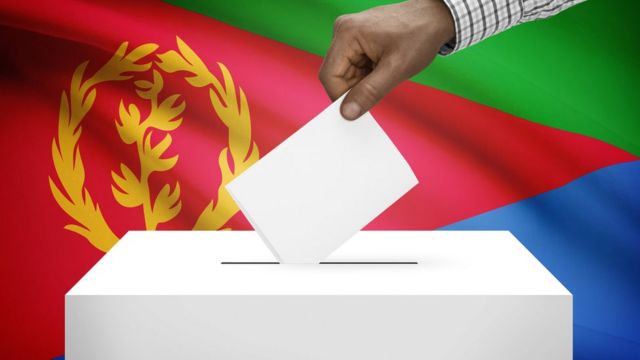
እቲ ነጻነቱ ኣረጋጊጹ፡ ቅዋማዊ ደሞክራሲያዊ ሕብረ ሰልፋዊ ስርዓት መስሪቱ፡ ቆጽሊ ብዘውደቐሉ መራሒ ንክነባበር ንሰለስተ ዓሰርተ ዓመታት ዝተቓለሰ ህዝቢ ኤርትራ፡ ክሳብ ሕጂ፡ ቅዋሙ ከይተግበረ፡ ደሞክራሲያዊ ምርጫ ከይጀመረ፡ ጽምብል 30 ዓመቱ ንምብዓል ይቀራረብ ኣሎ።
ግን ስለምንታይ እዩ ከምኡ ኮይኑ? ስለምንታይ እዩ ፕረዚደንት ኢሳይያስ ሃገራዊ ምርጫ ክግበር ዘየፍቀደ? ስለምንታይ'ከ እዩ ነቲ ኣብ ቃልሲ ዝምርሓሉ ዝነበረ መትከል 'ምምስራት ሕብረ-ሰልፋዊ ስርዓት' ነጺጉዎ? ስለምንታይ'ከ ንደሞክራሲያዊ ምሕደራ ተሓሲሙ - ምልኪ ሰሪቱ?
ቢቢሲ ትግርኛ፡ ንኣቶ ኤልያስ ሃብተስላሰ፡ ኣብ ዩኒቨርስቲ ቤርቬክን ሕቡራት መንግስታት ኣመሪካን ሆላንድን ዝምህር ንዝነበረ ናይ ሕጊ ምሁር፡ ንገዲም ተጋዳላይ ዳዊት ፍስሃየ ከምኡ እውን ንተጋዳላይ መጎስ ብርሃነ ኣዘራሪቡ ኣሎ ርእይተኦም እነሆ።
መትከላት ቃልሲ
ሓርነታውያን ውድባት ተሓኤን ህዝባዊ ግንባርን፡ መግዛእታዊ ስርዓት ኣሊኻ "ቅዋማዊት ደሞክራሲያዊት ነጻ ኤርትራ ምትካል" ዝብል መትከል ሒዘን ተቓሊሰን።
እቲ ኣብ ሳሕል ኣብ ዝተኻየደ ካልኣይን ሓድነታውን ጉባኤ (1987)፡ ዝወጽአ ሃገራዊ ደሞክራሲያዊ ፕሮግራም ይኹን፡ እቲ ኣብ 1994 ሳልሳይ ውድባዊ ጉባኤ ዝጸደቐ ሃገራዊ ቻርተር ፡ ቀንዲ ዕላምኡ "ቅዋማዊ ደሞክራሲያዊ መንግስቲ ምፍጣር" ምንባሩ ገዲም ተጋዳላይ ዳዊት ፍስሃየ ይገልጽ።
ብተወሳኺ ኣቶ ዳዊት፡ እቲ ፕሮግራም፡ ኣብቲ "ምምስራት ደሞክራሲያዊ መንግስቲ" ዝብል ኣርእስቲ፡ "ቀንዲ ዕላማ እቲ ቓልሲ፡ ንጥቕሚ ሓፋሽ ህዝቢ ዚሕሉ መንግስቲ ምትካል ኮይኑ፡ ብደሞክራስያዊ መንገዲ ካብ ዝተመርሐ ነጻ ናይ ህዝቢ ወኪላት፤ ቅዋም ዝሕንጽጽ ፡ ሓዲሽ ውዑላት ዘጽድቕ፡ ህዝባዊ፡ ፈጻምን ፍርዳውን ኣካላት ዝመርጽ፤ ኩሉ ዓይነት መሰላት ዜጋታትን ውዳበታትን ዘኽብርን ዘረጋግጽን፡ ንዜጋታት ኣብ ቅድሚ ሕጊ ብዘይ ኣድልዎ ብማዕረ ዝርእን ዘገልግልን ህዝባዊ ባይቶ ምቛም" ከምዝነበረ ንሰነዳቱ ብምጥቃስ የረድእ።
እቲ ኣብ ሳልሳይ ውድባዊ ጉባኤ፡ ኣብ 1994 ዝጸደቐ ሃገራዊ ቻርተር እውን ነቲ ናይ 1987 ሃገራዊ ደሞክራሲያዊ ፕሮግራም ሓሳብ ከምዝደገመን ዝጠቅስ ተጋዳላይ መጎስ ብርሃነ፡ እቲ ዝትከል ስርዓት፡ 'ሕግን ስርዓትን ዘኽብር፡ ሓድነትን ሰላምን ዝሕሉ፡ ኩሉ ኤርትራዊ ካብ ፍርሕን ጭቆናን ሓራ ኮይኑ፡ መሰረታዊ ሰብኣዊ መሰላቱ ተሓልይሉ፡ ህይወቱ፡ ብቕሳነትን ሓጎስን ንምቕጻልን ንምምሕያሽን ዘኽእል፡ ናጽነትን ጸጥታን ሃገር ዝሕሉ ሃገራዊ ቅዋማዊ ደሞክራሲያዊ ፖለቲካዊ ስርዓት ምህናጽ" ከምዝነበረ ይሕብር።
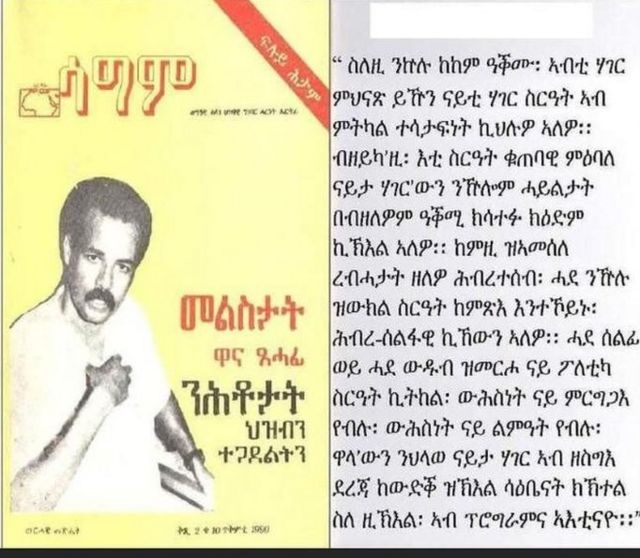
ምንጪ ስእሊ,S.M
ከም ኣብነት ከኣ ነቲ ፕረዚደንት ኢሳይያስ፡ ኣብ 1990 ዋና ጸሓፊ ህዝባዊ ግንባር ኣብ ዝነበረሉ ኣብ ገበር እታ መጽሔት ካብ ቃለ መሕትቱ ዝተወስደ፡ " ኵሉ ከከም ዓቕሙ፡ ሃገር ኣብ ምህናጽ ይዅን ኣብታ ሃገር ኣብ ዝትከል ስርዓት ተሳታፍነት ኪህሉዎ ፤ ….ሓደ ንዅሉ ዝውክል ስርዓት ክመጽእ እንተኾይኑ ከኣ፡ ሕብረ-ሰልፋዊ ኪኸውን ከምዘለዎ፡ ሓደ ሰልፊ ወይ ሓደ ውድብ ዝመርሖ ናይ ፖለቲካ ስርዓት ግን ውሕስነትን ምርግጋእን ከምዘይፈጥር ንዝገለጾ ከም ኣብነት ይጠቅስ።
ነቲ ፕረዚደንት ኢሳይያስ፡ "[ምናልባት እውን] ንህላወ ናይታ ሃገር ኣብ ዘስግእ ደረጃ ከውድቕ ዝኽእል ሳዕቤናት ክኽተል ስለ ዚኽእል፡ ኣብ ፕሮግራምና ኣእቲናዮ [ኣለና]" ዝበሎ ብምልዓል ሽዑኡ፡ እቲ ግንባር ደሞክራስያዊ ፖለቲካዊ ስርዓት ንምትካል ከም ቀዳማይ ዕላማ ሒዙ ይቃለስ ከምዝነበረ ኣረዲኡ።
እሞ'ኸ ደኣ እቲ ኩነታት ብኸመይ ቀጺሉ?
ህዝቢ ኤርትራ፡ ብ1993 ኣህጉራዊ ማሕበረሰብ ብዝተዓዘቦ ህዝባዊ ረፈረንዱም ብ99.8%፡ ብድምጹ ሕርያ ናጽነቱ ኣረጋጊጹ ኣባል ማሕበረሰብ ዓለም ኮይኑ።
ብ19 ግንቦት 1993 ከኣ ብኣዋጅ 37/1993፦ ሕገ-መንግስትን ሕጊ ፕረስን ዘርቅቕን ዘጽድቕን ከምኡ እውን ፖለቲካውያን ውድባት ዝምርሓሉን ሃገራዊ ምርጫ ዝካየደሉን ሕጊ ዘዳሉ፡ ናይ ኣርባዕተ ዓመት ዕድመ ስልጣን ዘለዎ ግዝያዊ መንግስቲ ከምዘቖመ ኣባል ማሕበር ኤርትራውያን ምሁራት ሕጊ ኣቶ ኤልያስ ሃብተስላሰ ነቲ ሰነድ ብምጥቓስ ይዛረብ።
እቲ ሓድሽ መንግስቲ፡ ግዝያዊ መንግስቲ ኤርትራ ተባሂሉ ከምዝፍለጥን፡ ሓጋጊ ፈጻምን ፈራድን ኣካላትን ከምዘጠቓልል እቲ ሽዑ ዝወጽአ ግዝያዊ ኣዋጅ የረድእ።
ክሳብ ኵናት ዶባት 1998-2000 ኣጋጢሙ እቲ መስርሕ ምትካል ቅዋማዊ ደሞክራሲያዊ መንግስቲ ዝሰናኸል ከኣ፡ ሃገራዊ ቅዋም ዝነድፍ ኮሚሽን፡ ኣብ ውሽጥን ወጻእን ንብዙሕ ክፋል ሕብረተሰብ ኣሳቲፉ፡ ብንቡር መስርሕ ዘተን ክትዕን ቅዋም ኣርቂቑ፡ ኣብ ግንቦት 1997 ከኣ ብሃገራዊ ባይቶ ኤርትራ ጸዲቑ።
ኣብ 1996 ከኣ ሕጊ ፕረስ እውን ረቒቑን ጸዲቑን፡ ጋዜጣታት ብሕቲ ተፈጢረን ዓምቢበን ነይረን።
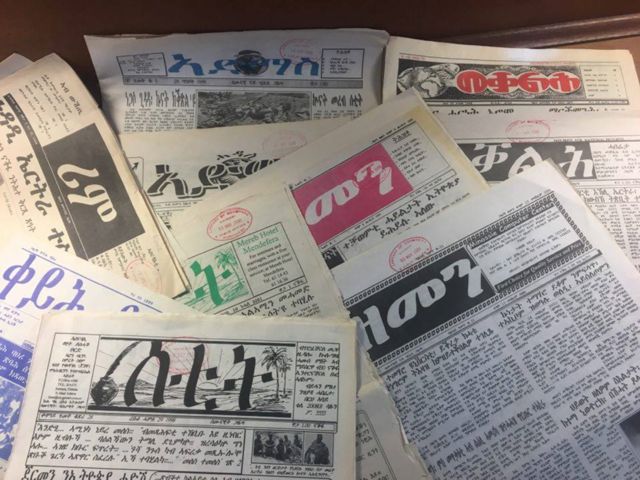
ምንጪ ስእሊ,PEN ERITREA/ ABRHAM T.
ናይ ብሕቲ ጋዜጣታት
ኣብ ህዝባዊ ረፈረንዱም 1993 ኮነ ኣብ ምርቃቕን ምጽዳቕን ሃገራዊ ቅዋም፡ " ኣባላት ተሓኤ ብምዃንና ጥራሕ ብስርዓት ህግደፍ ካብ ሃገራዊ ጉዳይና ብፍላጥ ተገሊልና" ዝብሉ፡ ኣብ ዝተፈለላየ ህዝባዊ ኣኼባታት ርእይተኦም ዘቕርቡ ሓያሎ ኤርትራውያን ተቓለስቲ ኣለው።
እቲ፡ "ነብሲ ወከፍ ሃገራዊ ኣብ ጉዳይ ሃገሩ ክሳተፍ ኣለዎ " ዝብል ዝነበረ ፕረዚደንት ኢሳይያስ ኣብ ጽባሕ ናጽነት፡ ኣብ ጉዳይ ሃገር ክዋስኡ ንዝሓተቱ ኣባላት ተሓኤ ነበር ዝተፈላለዩ ውድባት፡ "ድሕሪ ሕጂ ናይ ፖለቲካ ሓሸውየ ኣይፍቀድን እዩ" ብምባል ከም ውልቀ ሰባት እምበር ከም ውድባት ክኣትው ከምዘይከእሉ ስለዝኸልከለ፡ " ባህሪያት ኢሳይያስ ብዕምቆት ንዘስተብሃለ፡ እቲ ድሌት ምምስራት ሕብረ ሰልፋዊ ስርዓት ኣብቶም መሳርሕቱ እምበር ኣብ ኢሳይያስ ዝነበረ ኣይመስለንን" ይብል ኣቶ ኤልያስ።
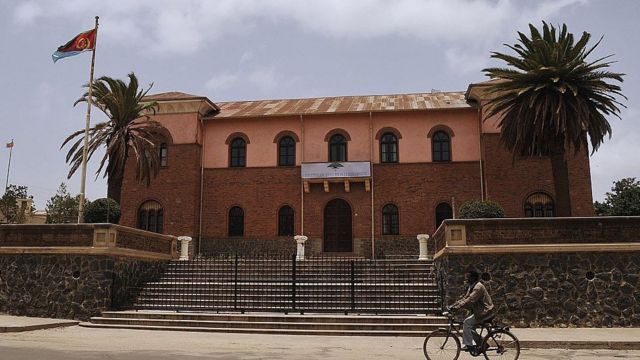
ምንጪ ስእሊ,AFP
ቤት ጽሕፈት ሃገራዊ ምርጫ ኤርትራ ነበር
ሓያሎ ኣባላት ሃገራዊ ባይቶን መንግስትን፡ ንኣተሓሕዛን ኣልያን እቲ ብዘተን ልዝብን ክውገድ ዝግበኦ ዝነበረ ኩናት ዶባት 1998-2000 ክግምገም ኣለዎ ብማለት ምስ ፕረዚደንት ኢሳይያስ ሓያል ዘይምርድዳእ ፈጢሮም ነይሮም።
ኣብ ዕጹው ኣኼባታቶም ብቐጻሊ ክዘራረቡ ድሕሪ ምጽናሕ ከኣ ኣብ ታሕሳስ 2001 ቀዳማይ ሃገራዊ ምርጫ ክካየድ፡ ብምውሳን ሕጊ ምርጫን ፖለቲካዊ ሰልፍታትን ውድባትን ዘርቅቓ ክልተ ሽማግለታት ተመዚዘን ስርሐን ጀሚረን።
እንተኾነ እቲ ዝረቐቐ ንድፊ ናብ ህዝቢ ወሪዱ ክትዕ ከይተገብረሉ ብፕረዚደንት ኢሳይያስ ምስተቛረጸ፡ እቲ ዝነበረ ዘይምርድዳእ ዓሪጉ ናብ ማእሰርቲ ላዕለዎት መራሕትን ምእጋድ ጋዜጣታት ብሕትን ኣምሪሑ።
እቲ ተወጢኑ ዝነበረ ሃገራዊ ምርጫ ከኣ ከም አርእስቲ እውን ከይተላዕለ ክሳብ ሕጂ ተናዊሑ ይርከብ።
ብርእይቶይ ይብል ኣቶ ኤልያስ ሃብተስላሰ፡ "እቲ ብሕብእቲ ሰልፊ ሰውራ ዝመርሐ ፕረዚደንት ኢሳይያስ ንኸምስል ደኣ'ዩ ሕብረ ሰልፋዊ ስርዓት ክንምስርት ኢና ዝብለና ነይሩ እምበር፡ እታ ኣብ 1994 ስርሓ ኣብቂዓ ፈሪሳ እያ ዝበለና ሕብእቲ ሰልፊስ ሕጂ እውን ነብሳ ወዲባ ብምስጢር ትሰርሕ ዘላ እዩ ዝመስለኒ። ቫንጋርድ ሰልፊ ከኣ ባዕሉ ክመርሕ እምበር ምስ ካልኦት ስልጣን ክሻረኽ ስለዘይፍቅድ፡ ብኸምኡ እዩ ምርጫ ካብ ምክያድ ክሕንግድ ጸኒሑ" ዝብል እምነት እዩ ዘሎኒ ይብል።
ተጋዳላይ ዳዊት ፍስሃየ ግን ኣብ 2001 ኣብ ኤርትራ ኣንጻር ምምስራት ደሞክራሲያዊ መንግስቲ ዕልዋ ከምዝተኻየደ እዩ ዝምጉት።
"ፕረዚደንት ኢሳይያስ፡ ንሃገራዊ ባይቶ ኣፍሪሱ፡ ንፈጻሚ ሽማግለ ኣልሚሱ፡ ቅዋማዊ መንግስቲ ንኽትከል ዝሓተቱ ናይ ቀረባ መሳርሕቱ፡ ብዘይ ወግዓዊ ክስን ንቡር መስርሕ ፍርድን ኣሲሩን ሰዊሩን ፖሊሳዊ መንግስቲ ዝመስረተ መታን ምርጫ ከይካየድ እዩ። ምኽንያቱ ምርጫ ምፍቃድ ማለት ተሓታትነትን ግሉጽነትን ምቕባል ማለት እዩ። ሓደ ሕጊ ጥሒሱ ብሓይልን ቅልጽምን ዘይሕጋዊ ተግባር ዝፈጸመ ሰብ ከኣ ብጉድለታቱ ክሕተት ኣይደልን እዩ" ብማለት ኢሳይያስ ክሳብ መጨረሽታ ዕድመኡ ምርጫ ዝበሃል ከምዘየፍቅድ ይዛረብ።
ተጋዳላይ መጎስ ብርሃነ እውን ምስ ርእይቶ ኤልያስ ዝመሳሰል ሐሳብ እዩ ዘለዎ።
እቲ ቀደም ኣብ እዋን ቃልሲ እውን እንተኾነ፡ ቃናን ቋንቋን ኩሉ ተቓላሲ፡ "ቅዋማዊ ደሞክራሲያዊ ሕብረ ሰልፋዊ ስርዓት" ምምስራት ዝብል ስለዝነበረ፡ ኢሳይያስ፡ ነቲ ሓፋሽ ክመስል እዩ ነቲ ሓሳብ ዝደጋግሞ ነይሩ እምበር፡ ከም ውልቀ ጠባይ መላኺ ስለዝኾነ፡ ብጽኑዕ ፖለቲዊ ትካላት ጥራሕ እዩ ክግታእ ዝኽእል - ሕማቕ ኣጋጣሚ ኮይኑ ከኣ ከምኡ ዓይነት ትካላት ንኸይንፈጥር ብኹሉ ዝከኣሎ ተቓሊሱ ስዒሩና'ዩ" ይብል።
ሓለፍቲ መንግስቲ ኤርትራ ግን " ቅድም ልዑላውነት ሃገር ክዕቀብን ክወሓስን ስለዘዎ፡ ሃገር ከየውሓስና ሰራዊት ከነጣይስ ይኹን ብዛዕባ ውሽጣዊ ጉዳያትና ክንዛረብ ግዜኡ ኣይኮነን" እናበሉ እዮም ክገልጹ ጸኒሖም።
ስለምንታይ ግን ኢሳይያስ ሓሳቡ ቀይሩ?
ኣብ ደሞክራሲያዊ ስርዓታት፡ መሪሕነት ማለት፡ ጾርን ሓላፍነትን ህዝብን ሃገርን ምስካም እዩ። ኣብ ምልካውያን መንግስታት ግን መሪሕነት ማለት፡ "ነብስኻ ዝኣዘዘካ ዊን ዝበለካ" ተግባራት ምፍጻም ዕድል ምርካብ እዩ። ኣብ ሓርነታዊ ቃልሲ፡ " ኤርትራ ድሒራ ነጻነታ ትጎናጸፍ ስለዘላ መራሕቲ ኣፍሪቃ ዝፈጸሙዎ ጌጋታት ብልሽውና ኣይክትደግምን እያ" ዝብል ፖለቲካዊ ኣስተምህሮ ይወሃብ ምንባሩ ዝዝክር መጎስ ብርሃነ፡ " ኣብ ጽባሕ ናጽነት ኣበራትና ዘለለየ ህዝቢ ካብቶም ብኹሉ ዓይነት ብልሽውና እንኸሶም ዝነበርና መራሕቲ ኣፍሪቃ ዝተሓትና ምዃንና ቀልጢፊ እዩ መዚኑና" ይብል።
ክሳብ ኵናት ዶባት ተኸሲቱ እቲ ነገራት ዝበላሾ ከኣ፡ ዝበዝሕ ተጋዳላይን ህዝብን " ነገራት ሎሚ ጽባሕ ክመሓየሽ እዩ" ኢሉ ብተስፋ ክቃለስ ጸኒሑ። ግን ኩሉ ነገር ከምቲ ትጽቢት ዝተገብረሉ ኣይከደን።
ኣብ 1988 ንፕረዚደንት ኢሳይያስ ኣብ ዓምበርበብ ሳሕል ብምኽንያት ስራሕ ብኣካል ረኺቡ ንኣስታት ኣርባዕተ ሰዓት ኣብ ጉዳይ ምምላስ ኤርትራውያን ስደተኛታት ዘዕለሎ ኣቶ ኤልያስ ሃብተስላሰ ይዝክር፡ "ኣብ መንጎ ዕላልና፡ ካብ ቻይና እንታይ ተማሂርኩም ኢሉ ከምዝሓተቶን፡ ሽዑ ኢሳይያስ ብዙሕ ነገር ከምዝተማህሩ፡ ግን ቻይናውያን ነቲ ሰብኣዊ ኣምልኾ ማኦ ( ፐርሰናል ካልት) ክቃለሱዎ ከምዝነበሮም ነጊሩና። ሕጂ ግን ባዕሉ ሰብኣዊ ኣምልኾ ፈጢሩ ንሃገር ብምልኪ ሒዙዋ ኣሎ" ክብል ተዘክሮኡ ይገልጽ።
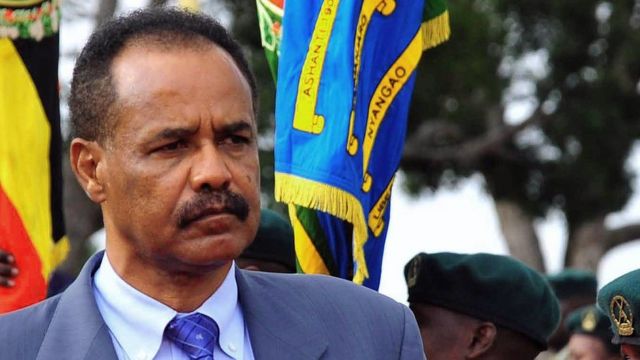
ኣብ 2000 ዓመተ ምሕረት ሰሙናዊ እትሕተም ጋዜጣ ጽጌናይ፡ ኣብ ሳልሳይ ዓመት ቁ-20 ሕታማ፡ " ህዝቢ ኤርትራ ኣብ ዝደለዮ[እዋን] ስልጣነይ ክገድፍ እኽእል እየ" ኣብ ትሕቲ ዝብል ኣርእስቲ፦ ፕረዚደንት ኢሳይያስ፡ ሓንቲ ኣብ ኣመሪካ እትሕተም ጋዜጣ "ስልጣን ክትገድፍ መደብ ኣለካ'ዶ ወይስ ከምቶም ብዙሓት መራሕቲ ኣፍሪቃ ክሳብ ትመውት ክትጸንሕ ኢኻ? ክትብል ንዝቐረበትሉ ሕቶ፡ "ህዝቢ ኤርትራ ስልጣነይ ንክገድፍ ኣብ ዝሓተተሉ እዋን፡ ዋላ እውን ጽባሕ እንተኾነ ስልጣን ንምግዳፍ ድለው እየ። እቲ ምርጫ ምሉእ ብምሉእ ናይ ህዝቢ እዩ" ክብል ንዝሃቦ መልሲ ሒዛ ወጺኣ ምንባራ የዘኻኽር ኣቶ መጎስ።
ኣስዒቡ፡ ነቲ ፕሪዘደንት ኢሳይያስ ኣብ መበል 17 ዓመት ናጽነት ኤርትራ ምስ ቴሌቪዥን ኣልጀዚራ ኢንግሊሽ ኣብ ዝገበሮ ቃለ መሕትት፡ ኣብ ኤርትራ መዓስ እዩ ምርጫ ክግበር ተባሂሉ ምስ ተሓተተ፡ " እቲ ኣብ ኣመሪካ ዝግበር ምርጫ እንታይ ፍረ ከምዘምጽእን ሓቀኛ ምርጫ ክሳብ እንርእን ን30 ወይ 40 ዓመታት ክንጽበ ኢና … " ንዝበሎ ኣብ ግምት ብምእታው ፕረዚደንት ኢሳይያስ ሃገራዊ ምርጫ ክገብር ድላይ ከምዘይብሉ ብቑዕ ኣብነት እዩ ይብል።
ኤርትራ ፍልጠትን ክእለትን ኣሻሓት ዜጋታታ ዝፈሰሶ ንኣስታት ሓሙሽተ ዓመት ዝተደኽሞ ሃገራዊ ባይቶ ዘጽደቖ ሕገ-መንግስቲ እናሃለዋ፡ ፕረዚደንት ኢሳይያስ ኣብ መበል 23 ዓመት ጽምብል ናጽነት ኤርትራ፡ "… ንኩነታትና ዝሰማማዕ ሓዲሽ ቅዋም ምንዳፍ ክጅመር እዩ" ክብል ዝሃቦ መግለጺ ንባዕሉ፡ ንሱ ክሳብ ዘሎ ኣብ ኤርትራ ምርጫ ዝበሃል ነገር ከምዘይሕሰብ ምስክር ምዃኑ ዝሕብር ኣቶ ኤልያስ ሃብተስላሰ - ኢሳይያስ ክሳብ ዘሎ ኤርትራ ሃገራዊ ምርጫ ትርኢ ኣይመስለንን ይብል።


































